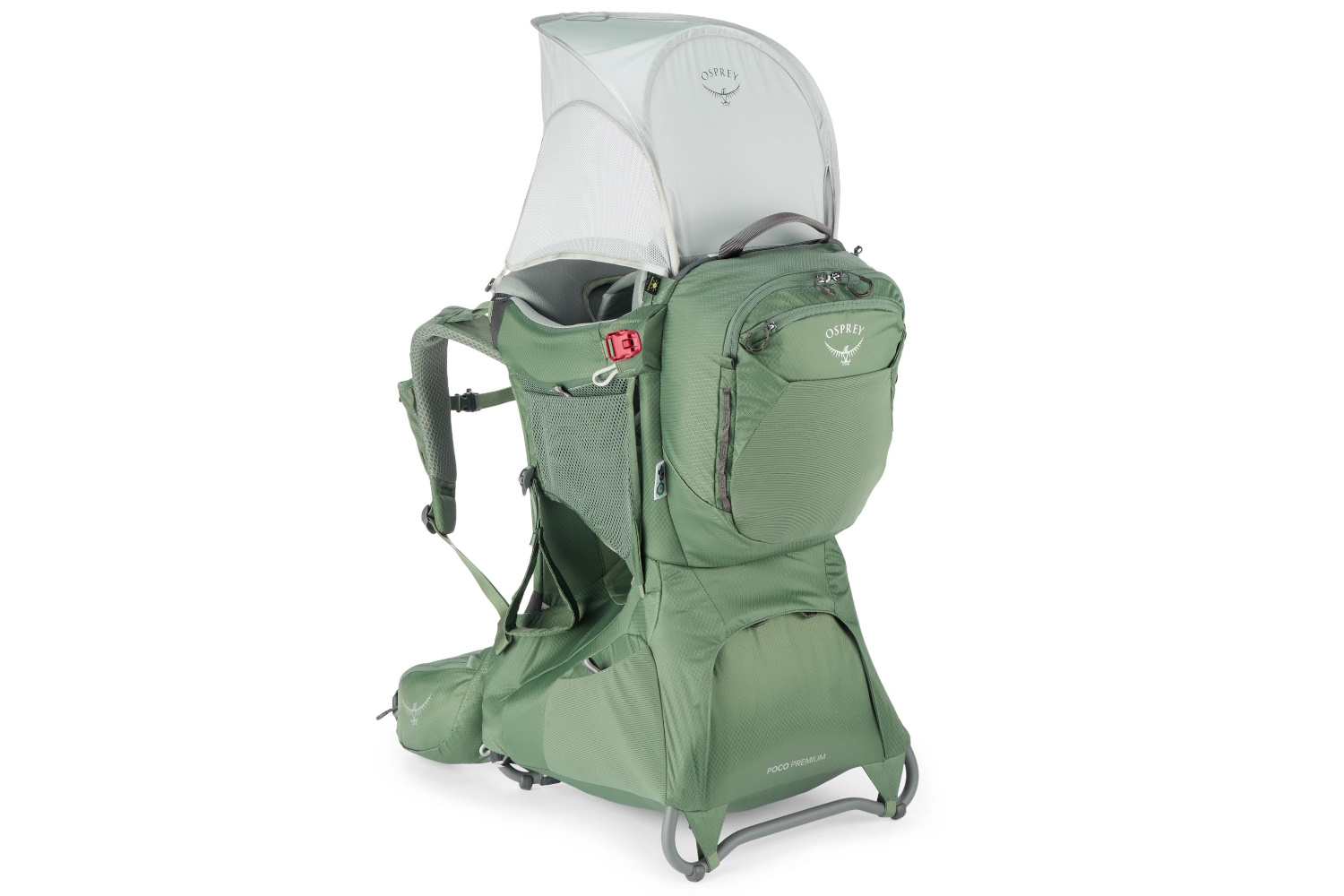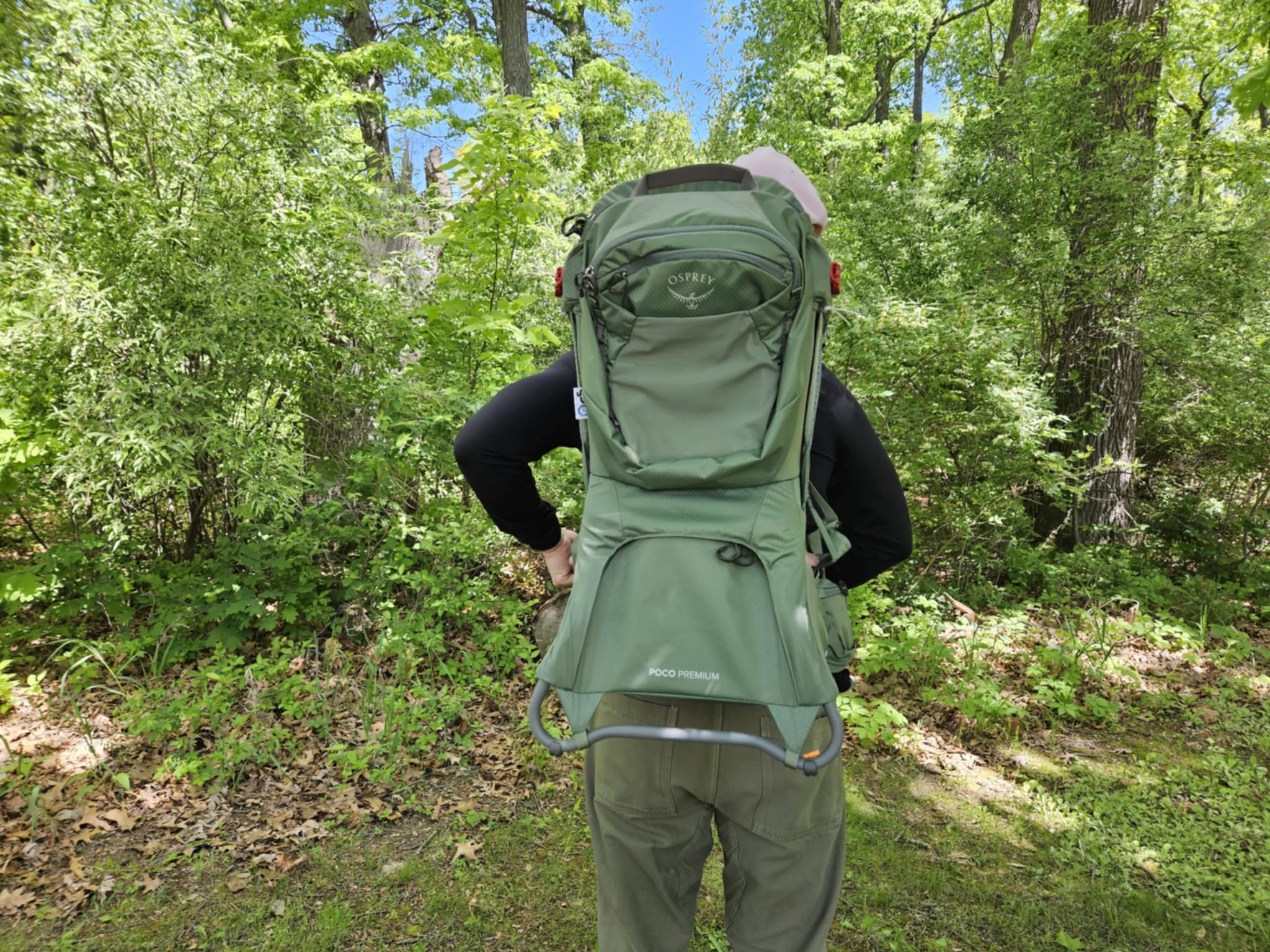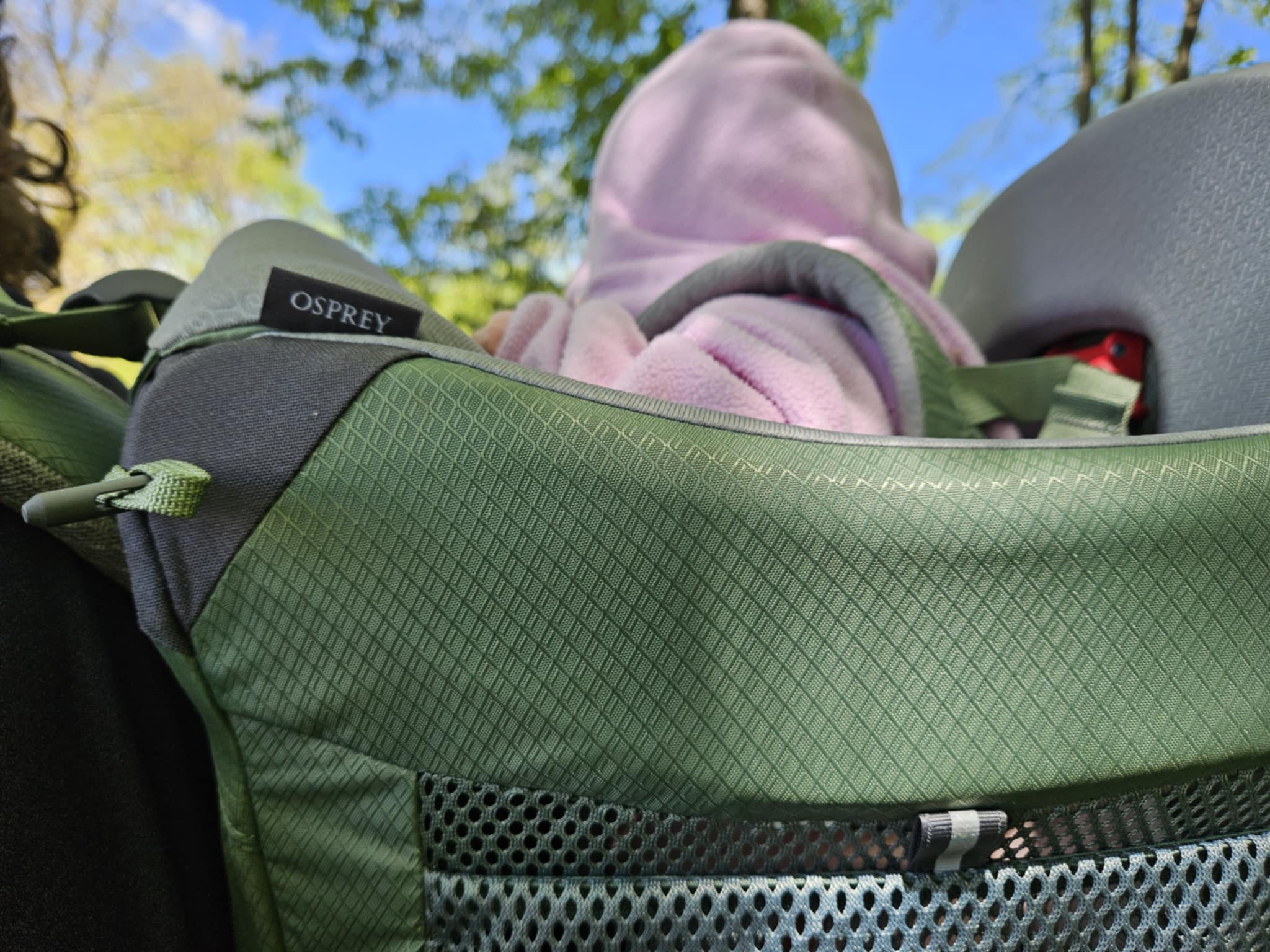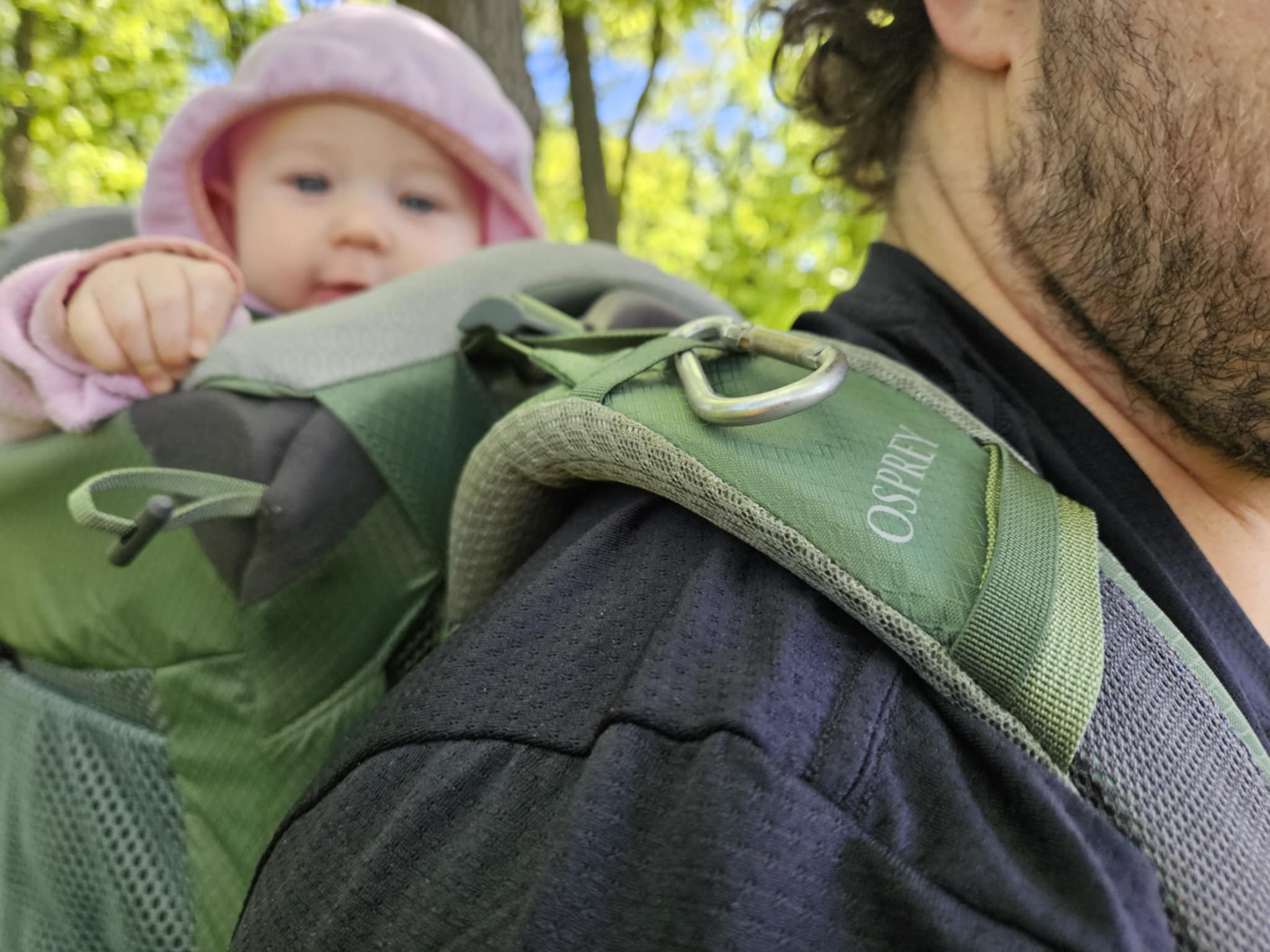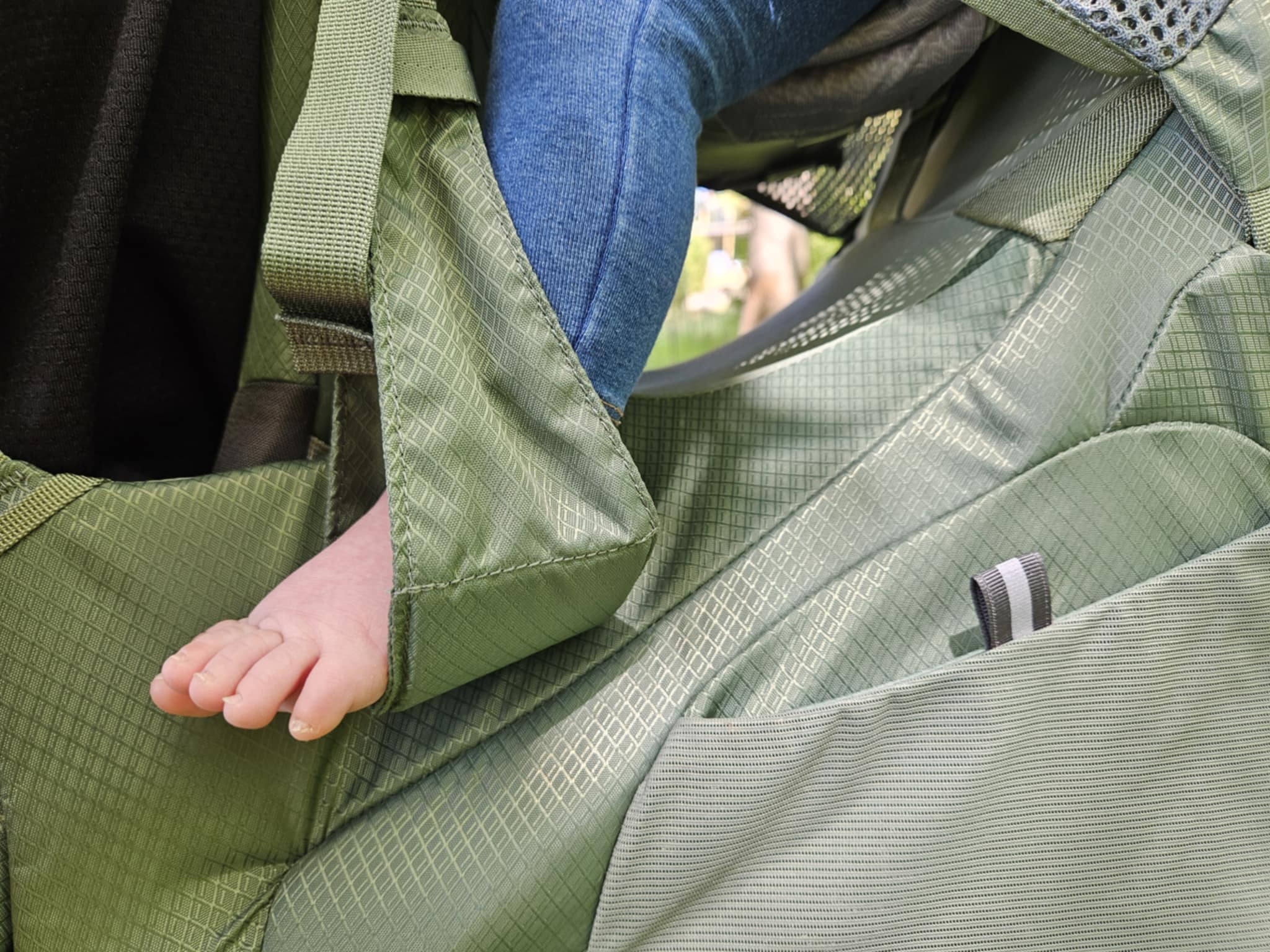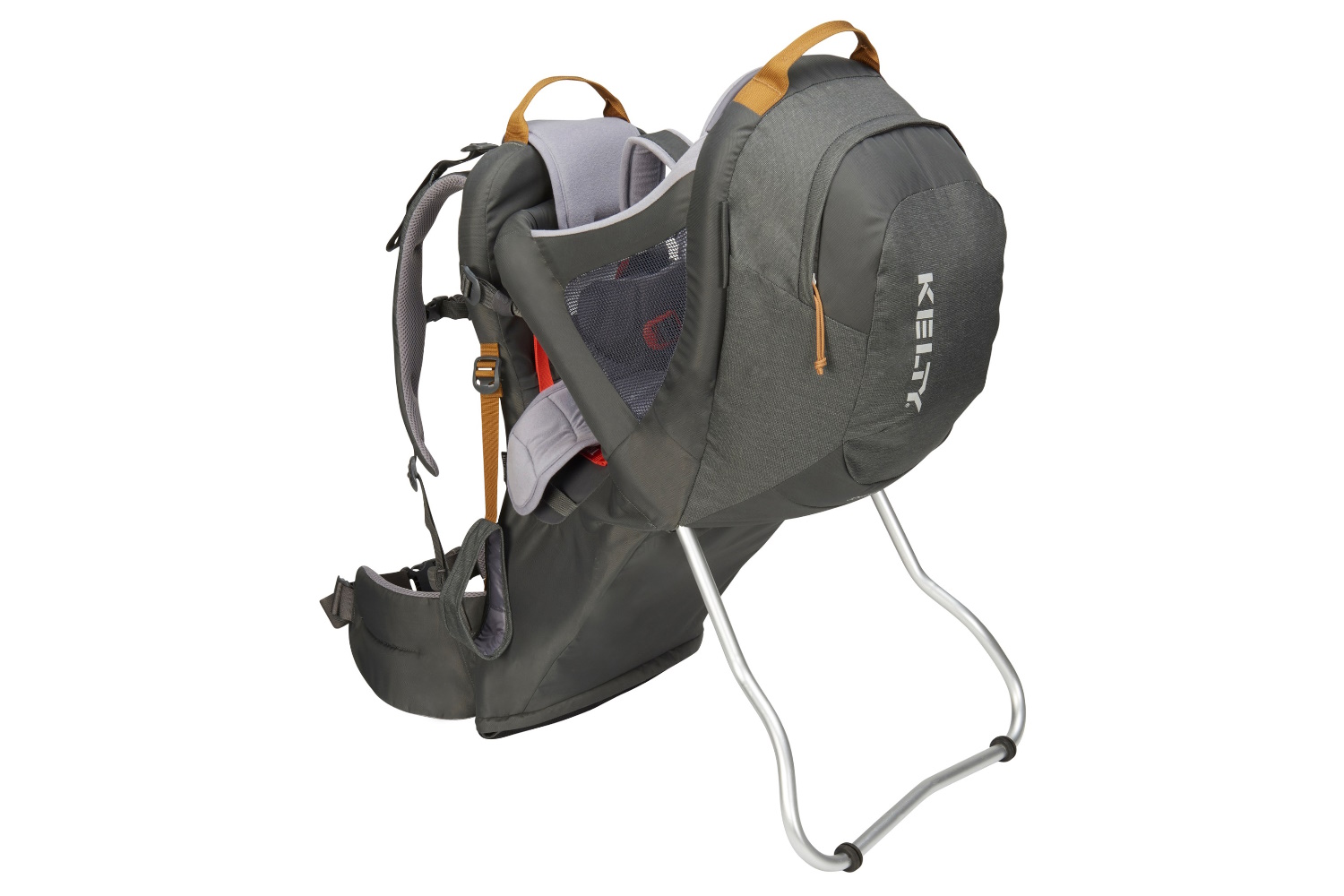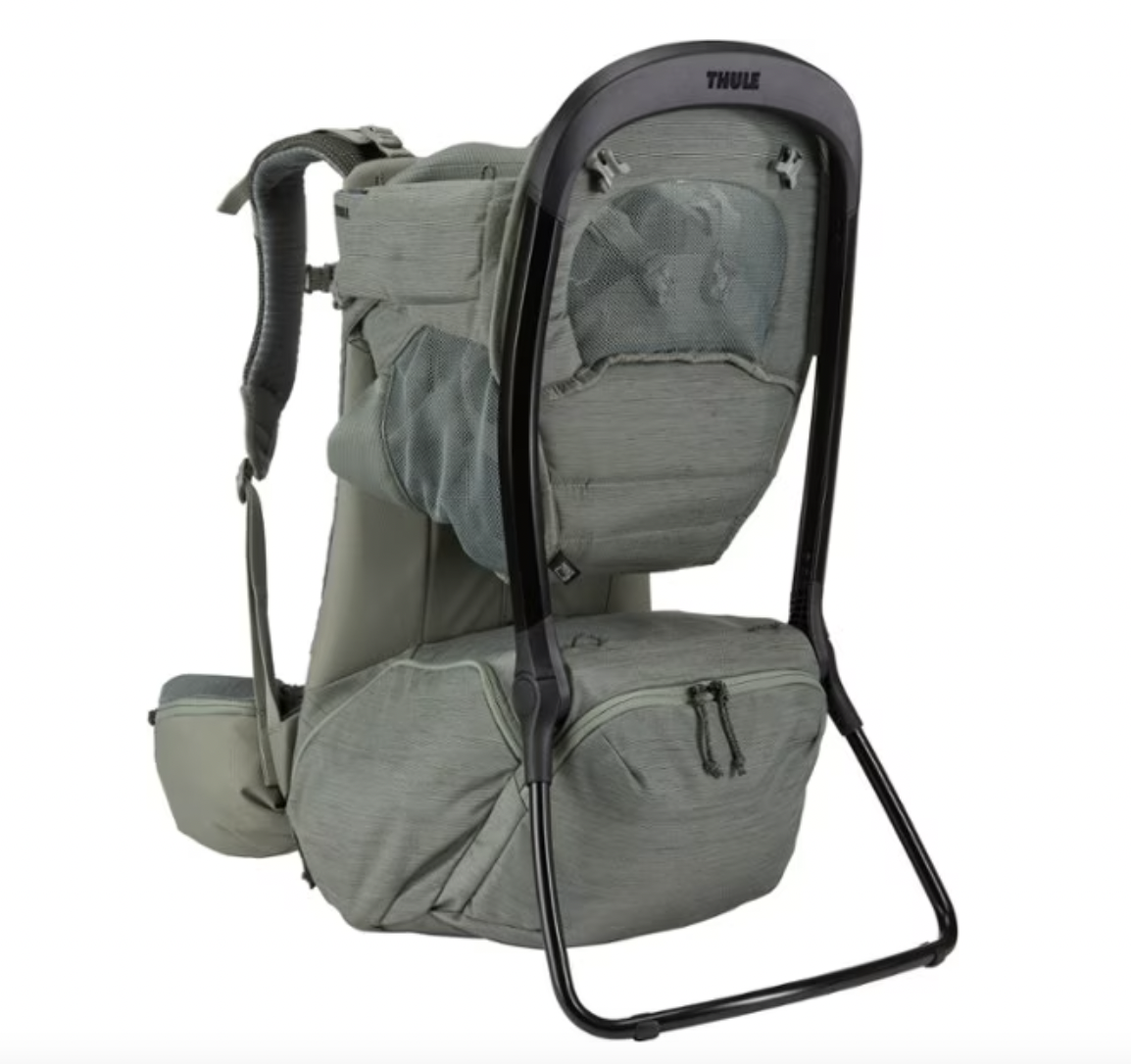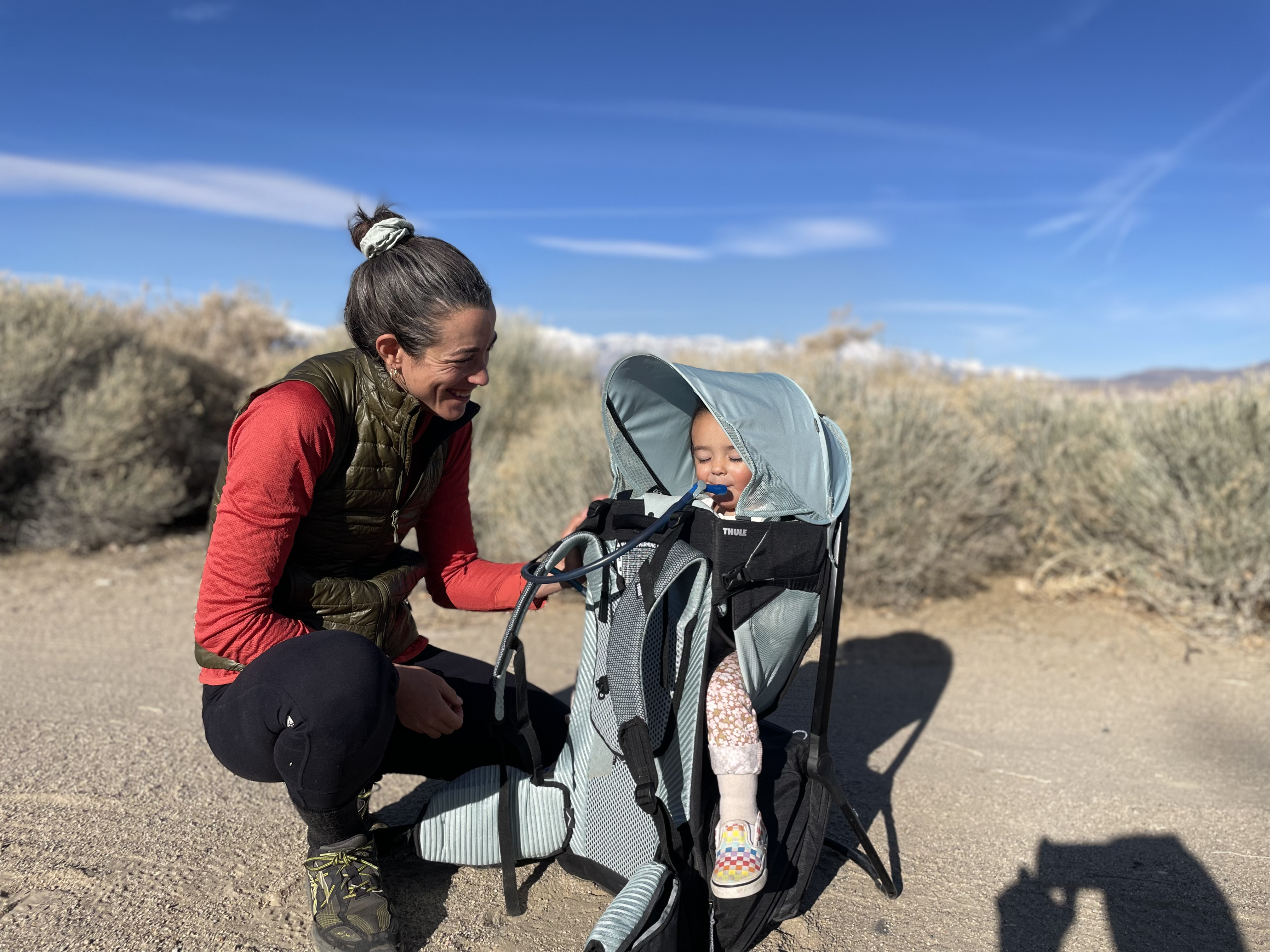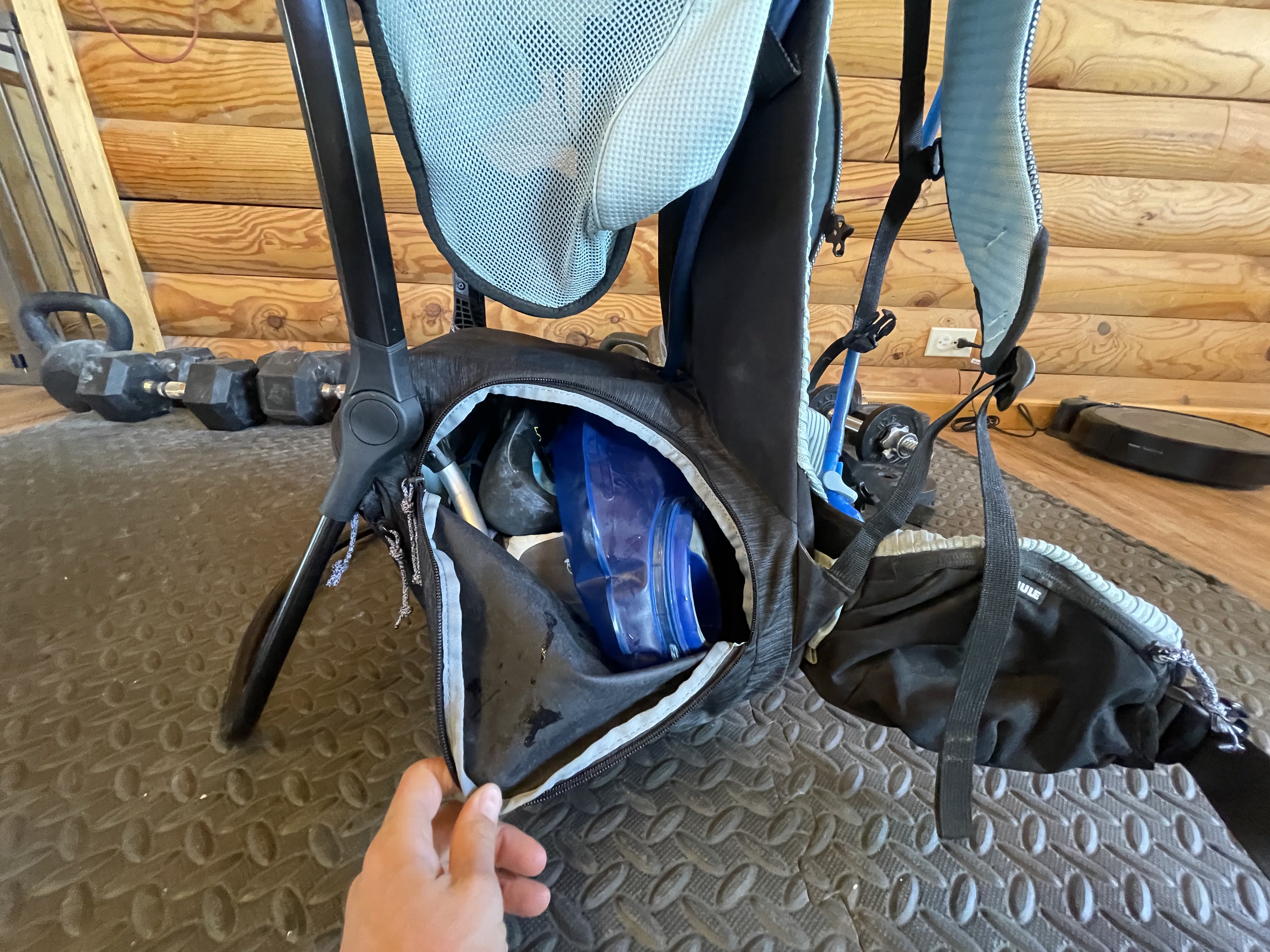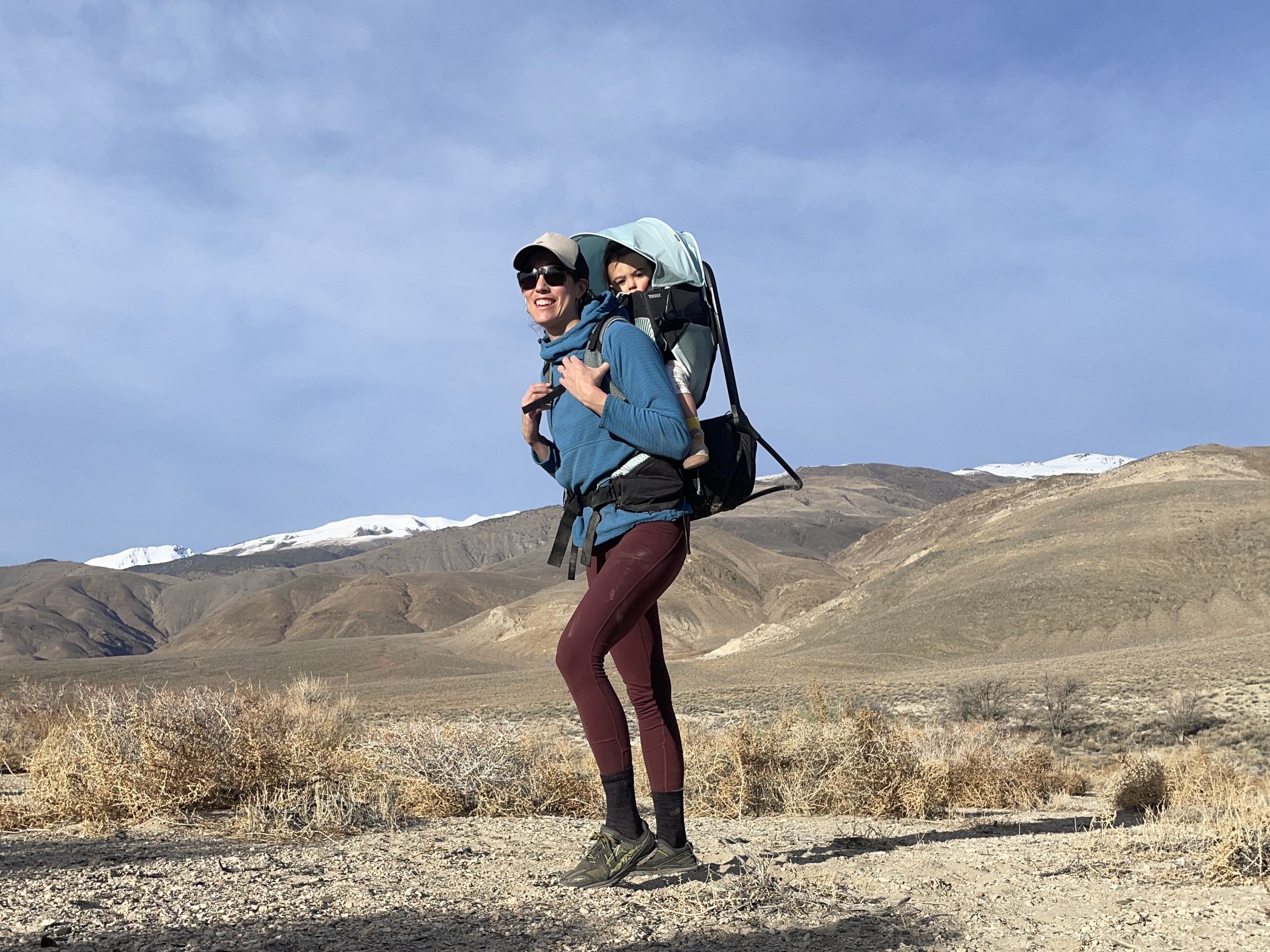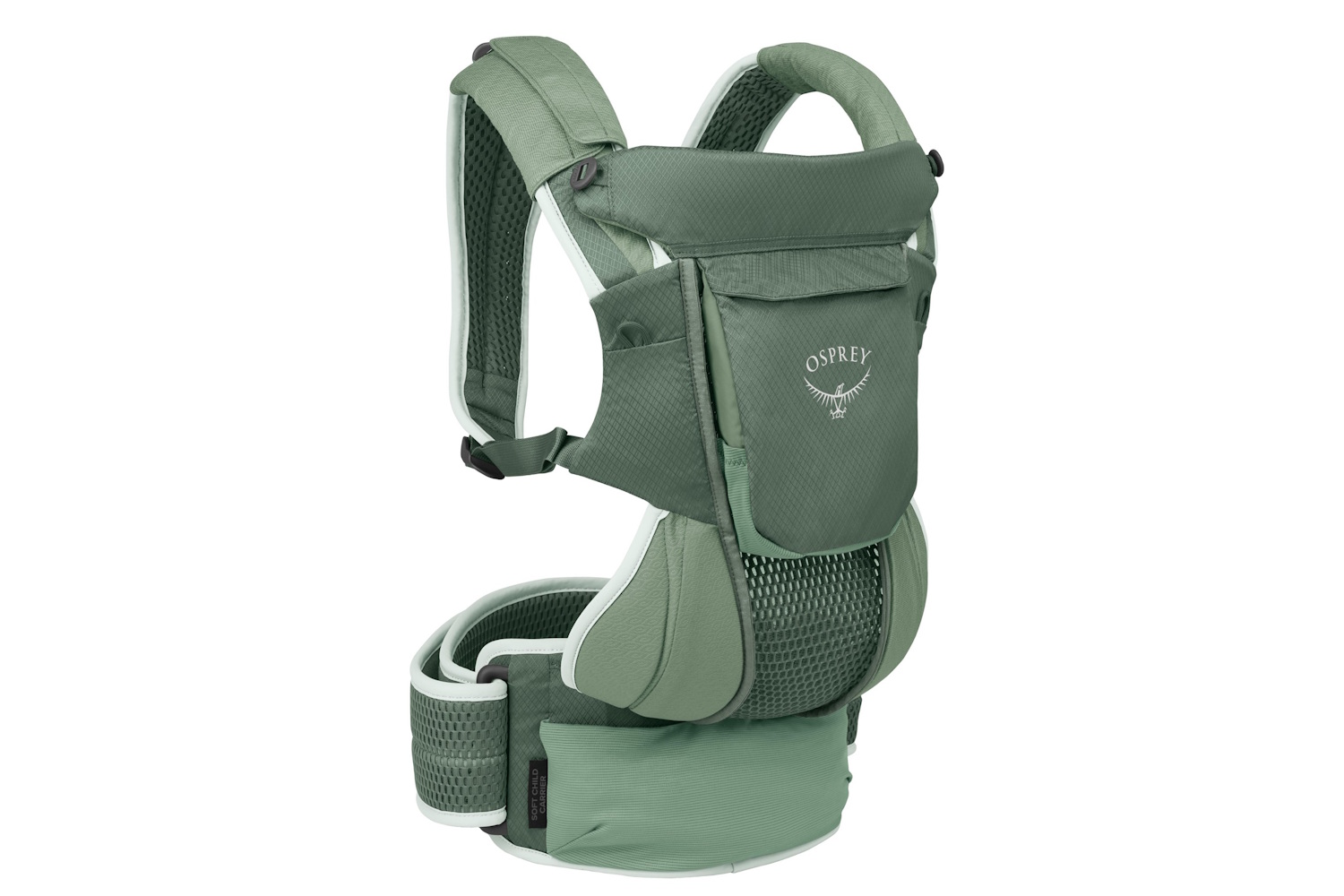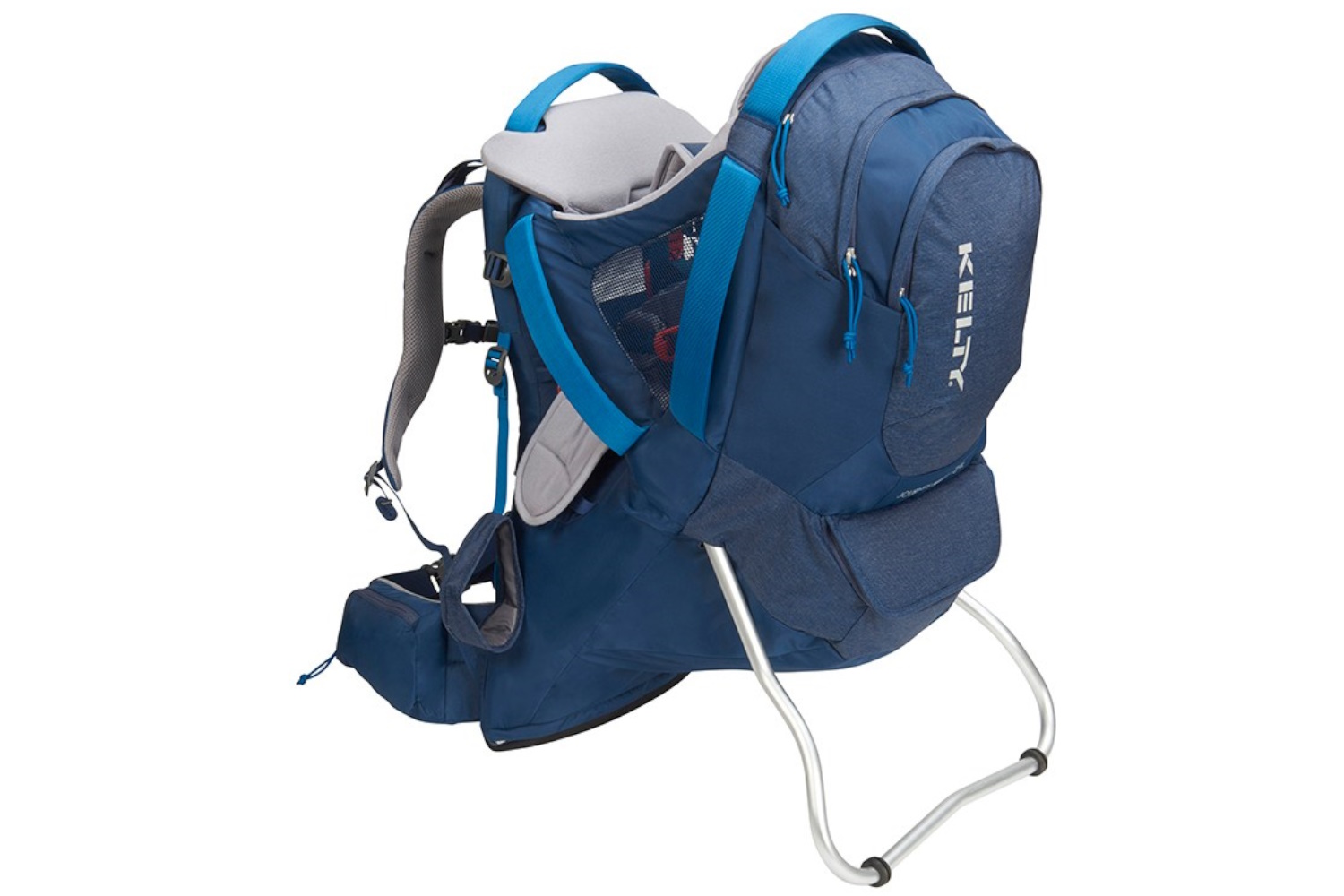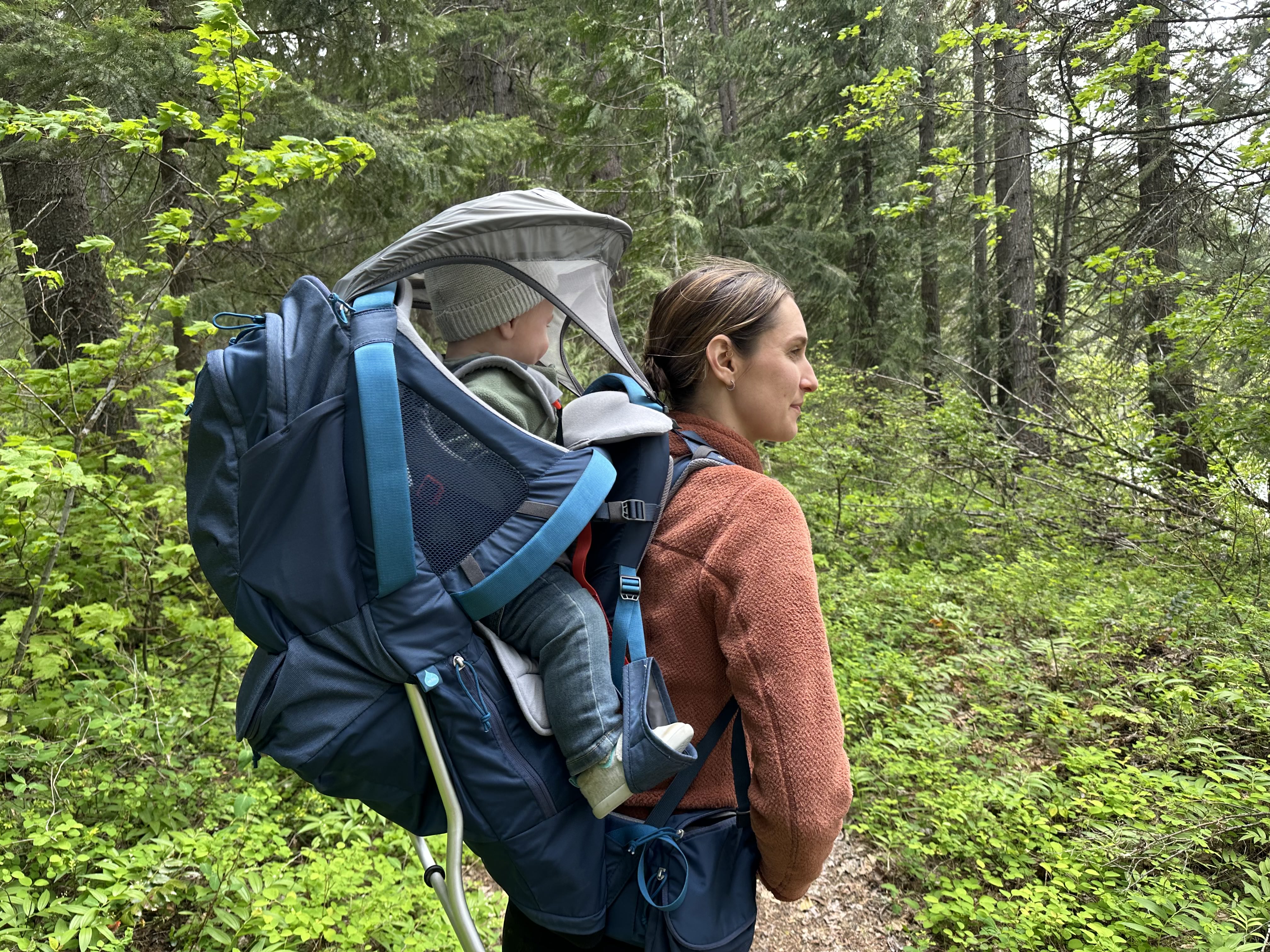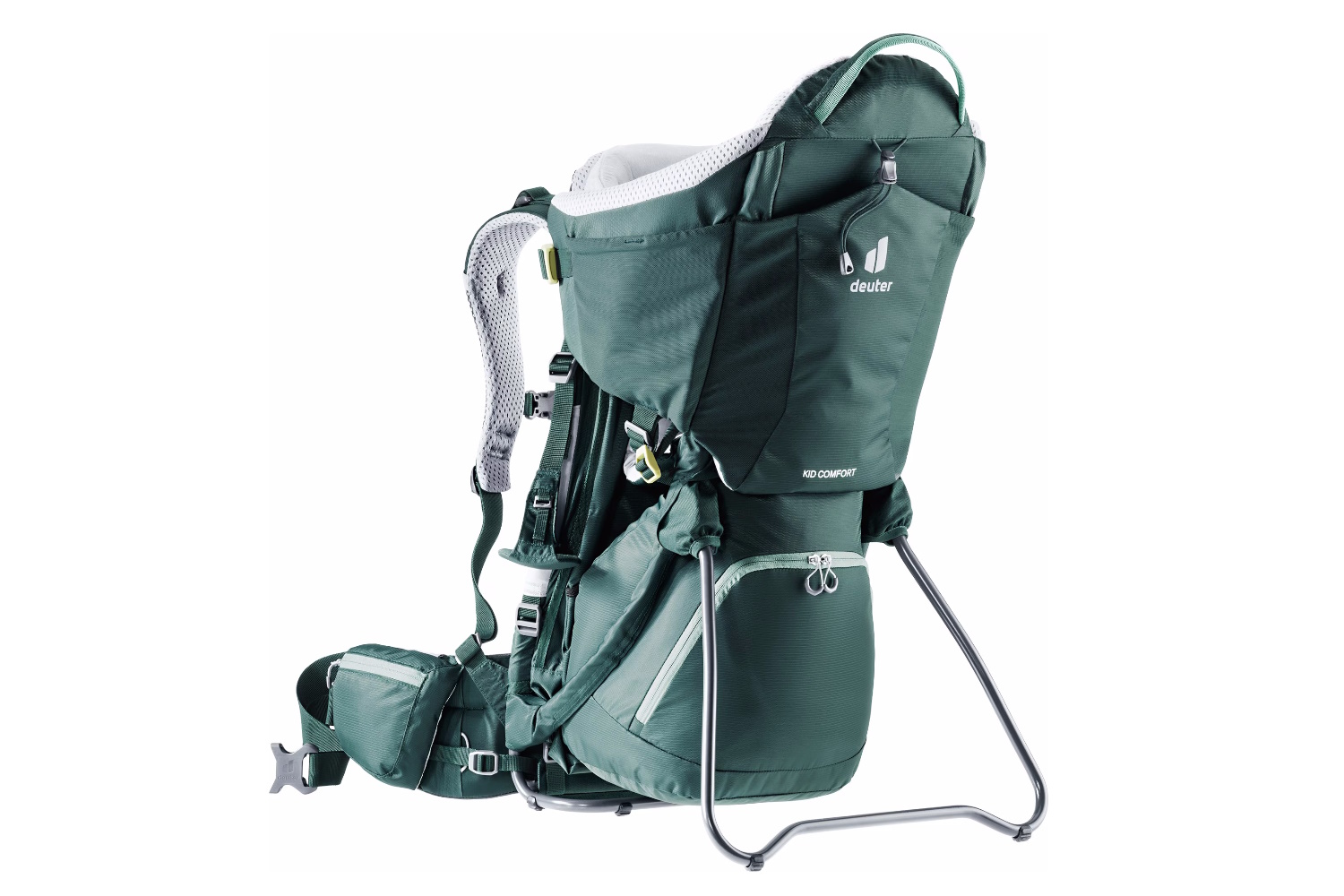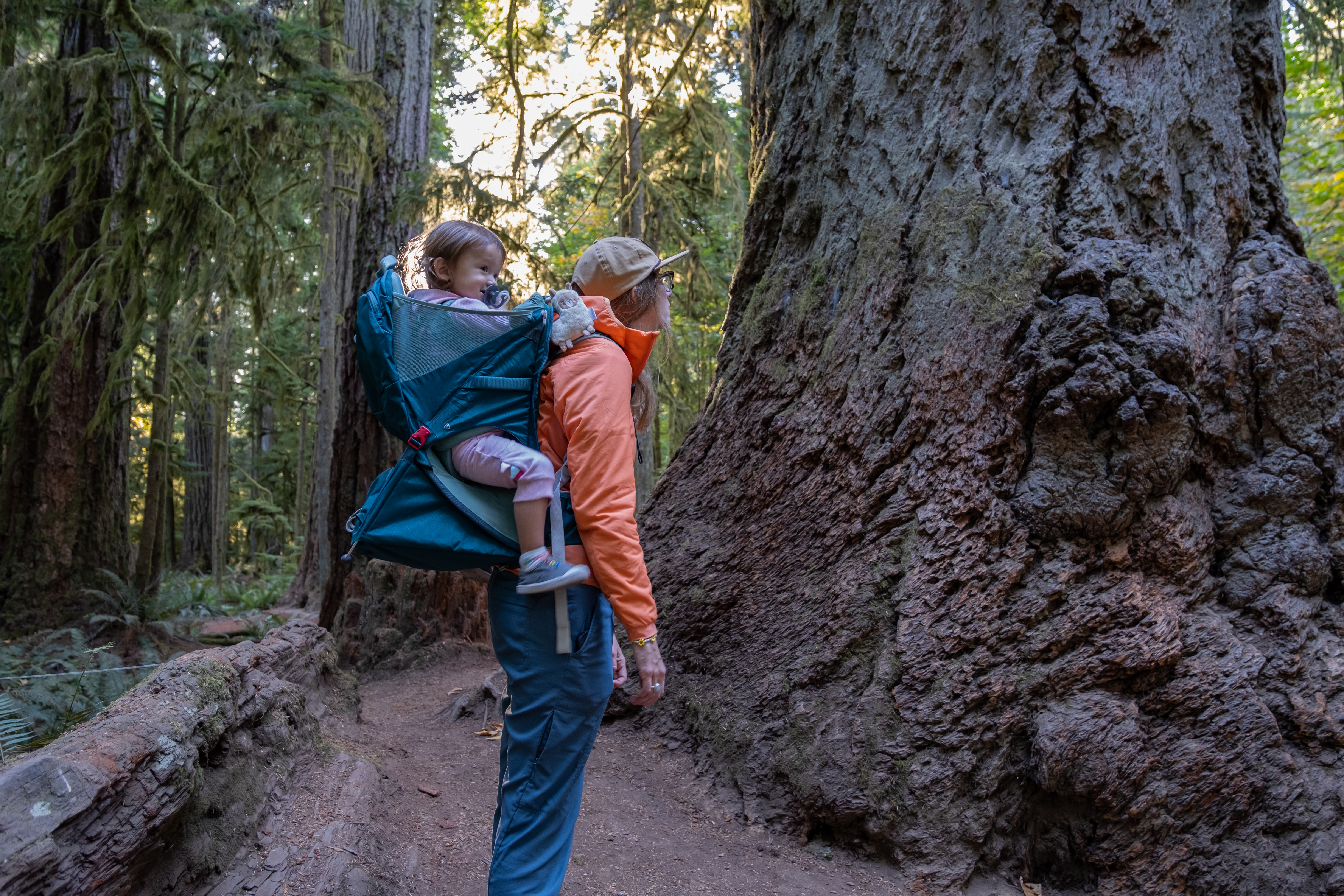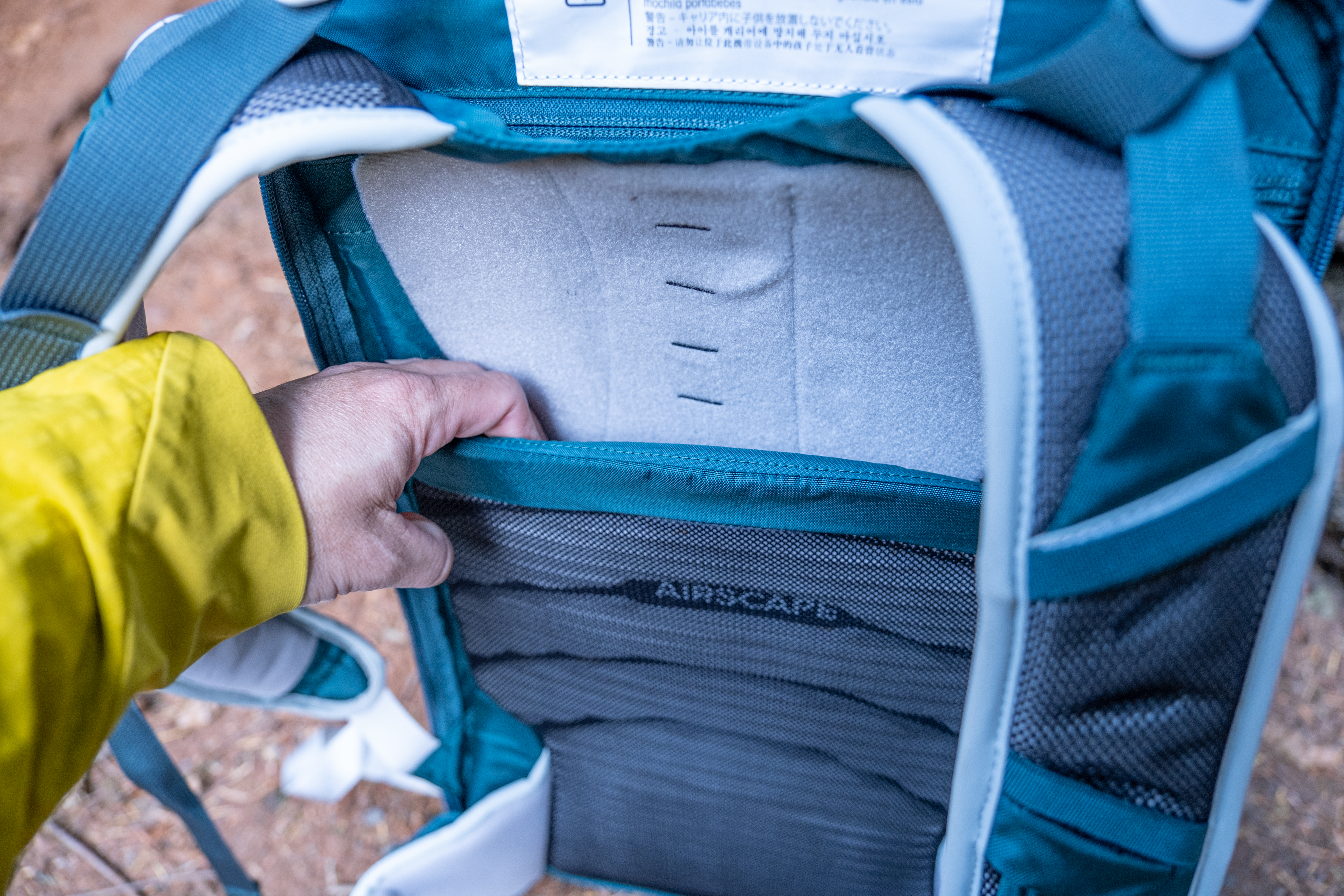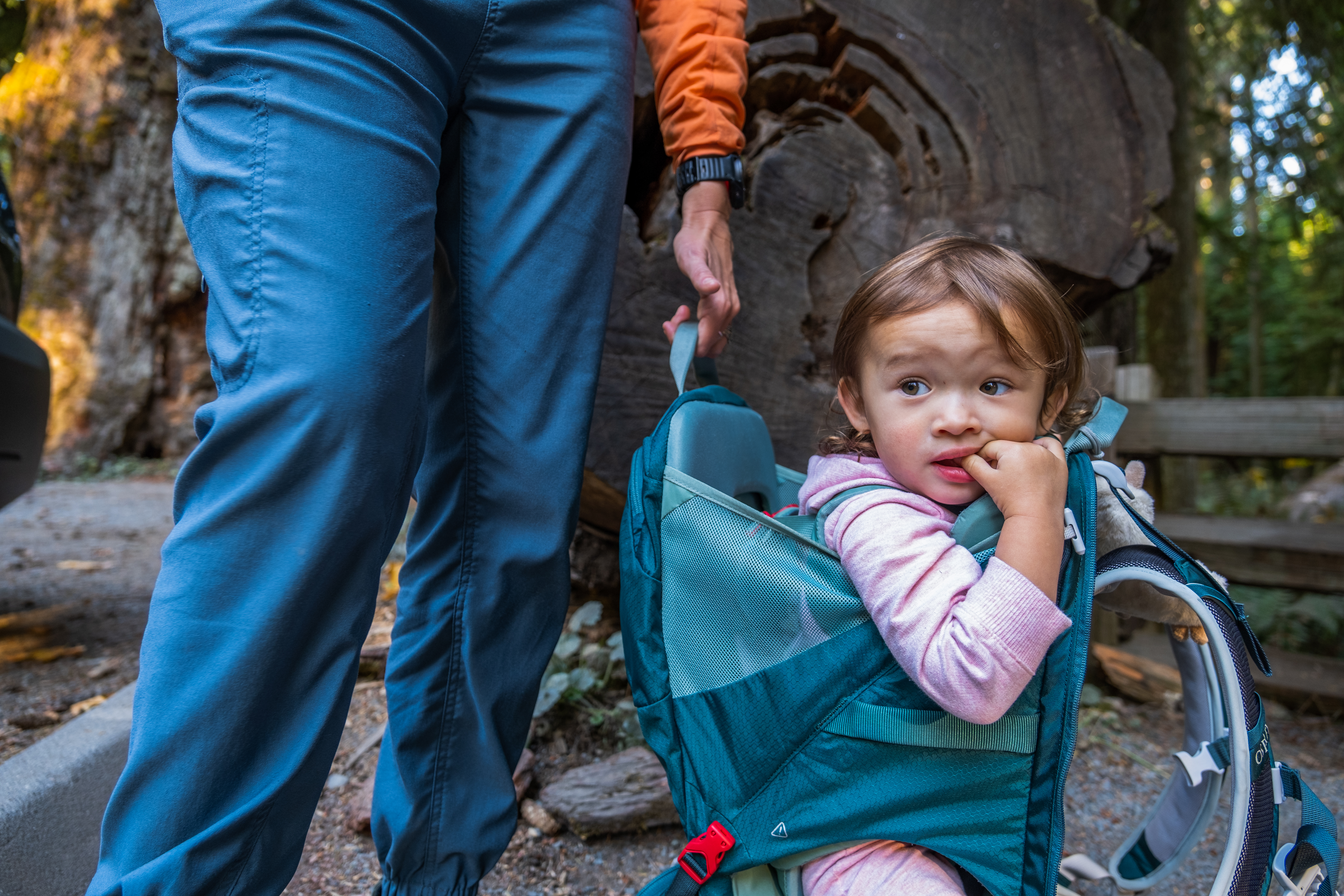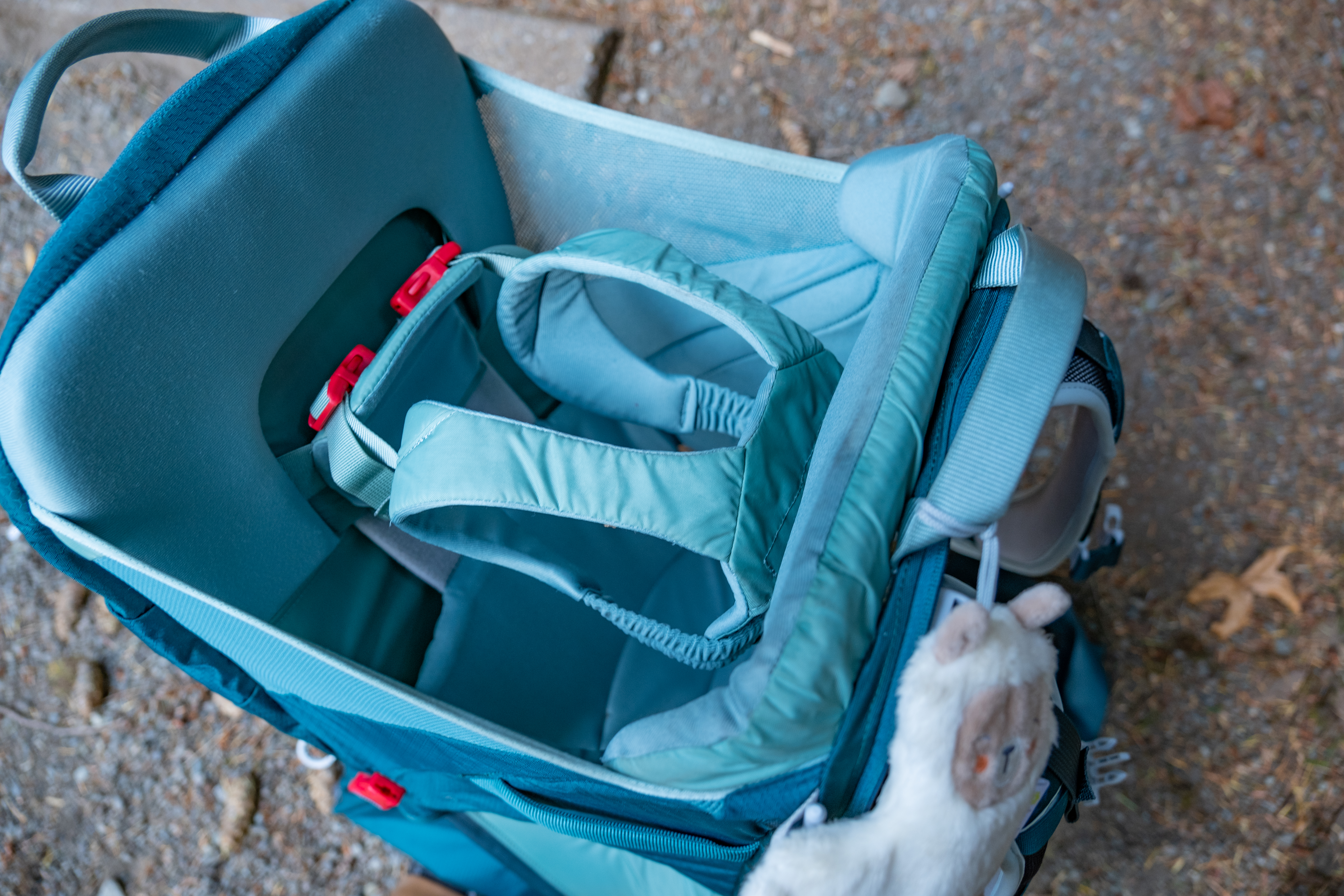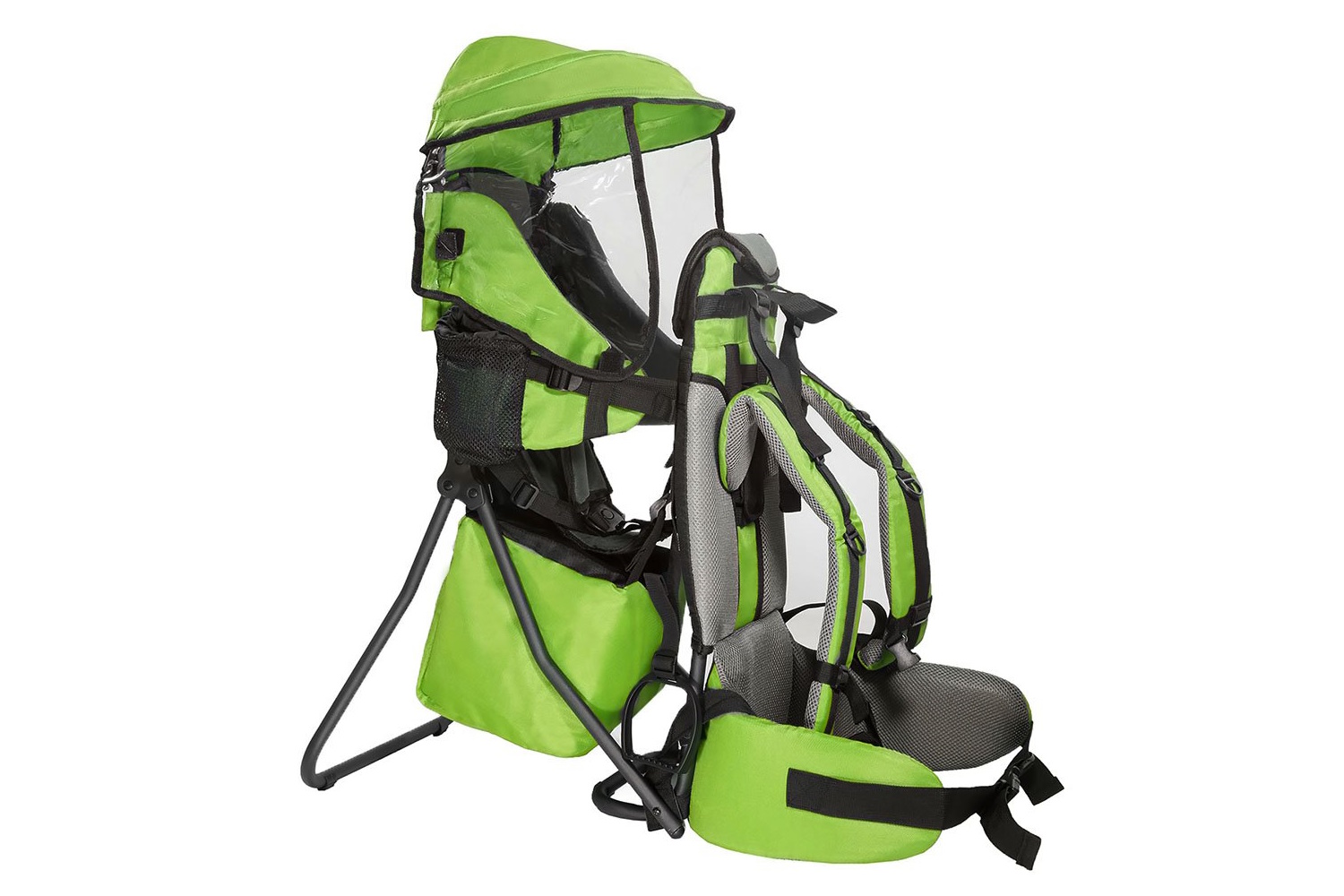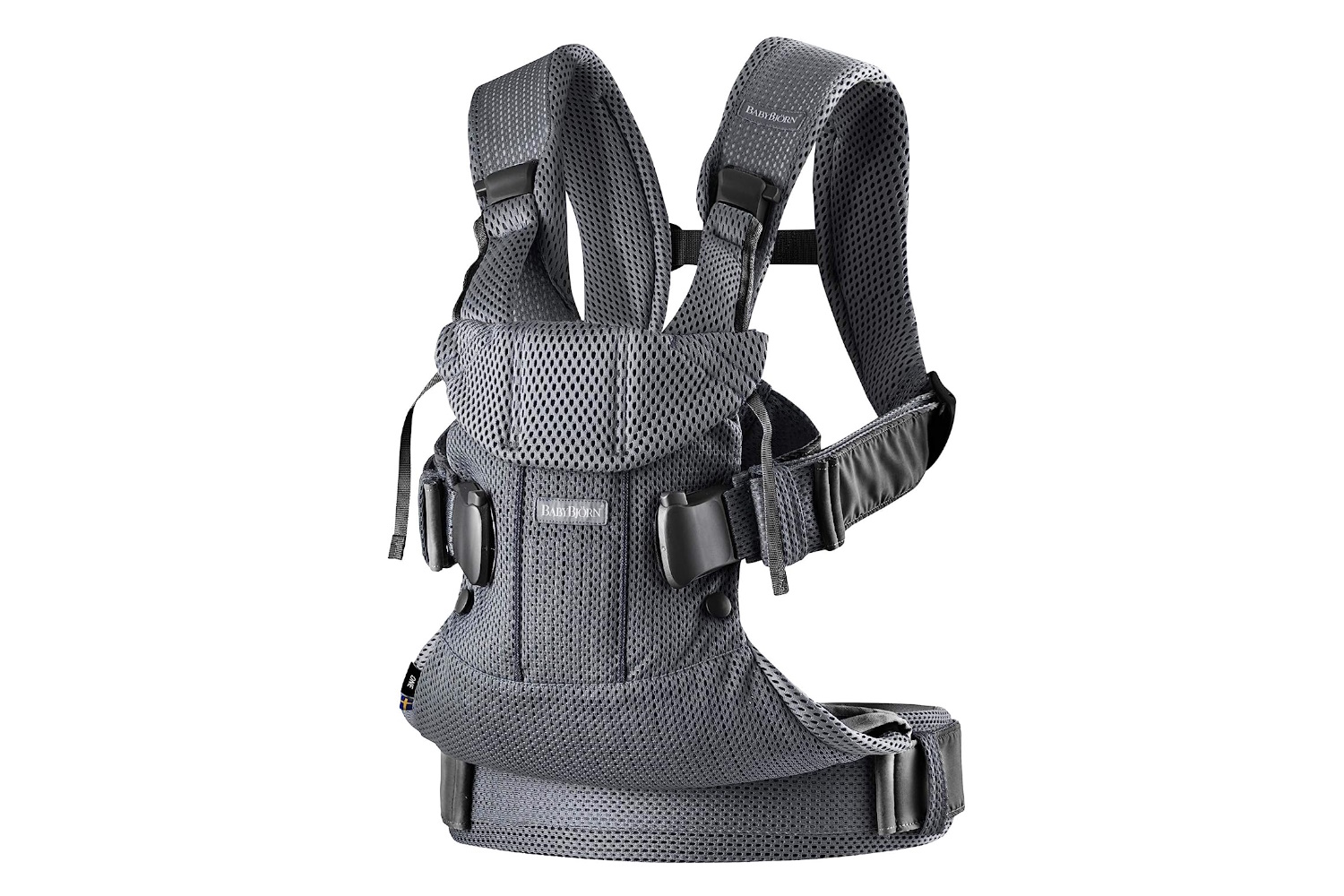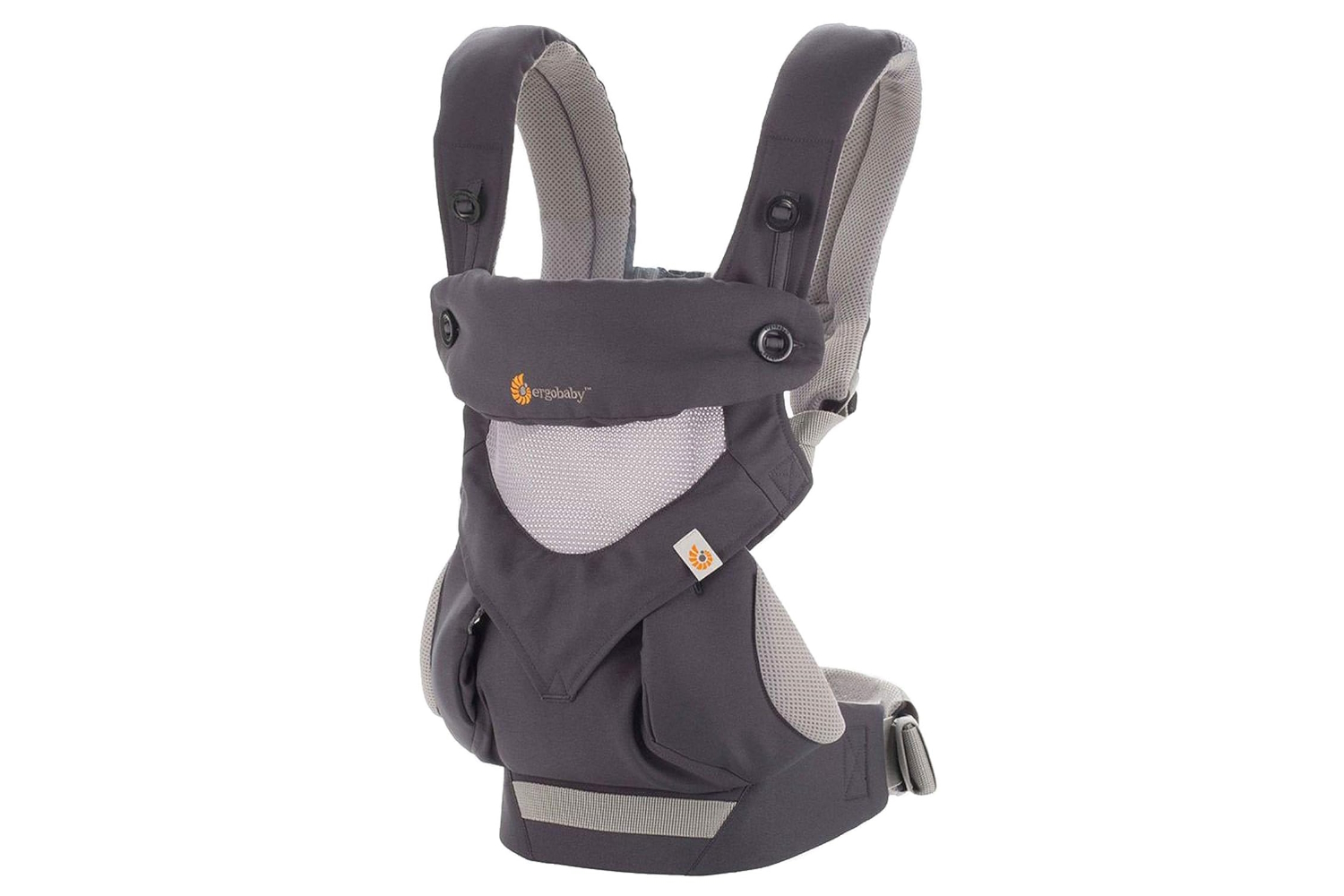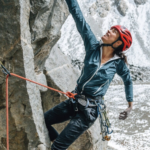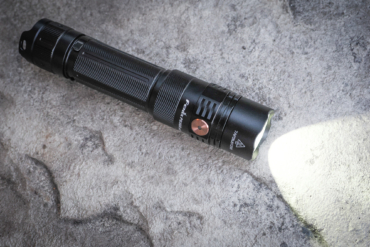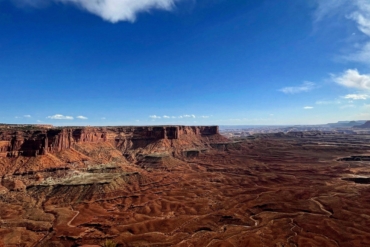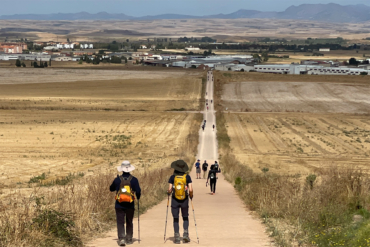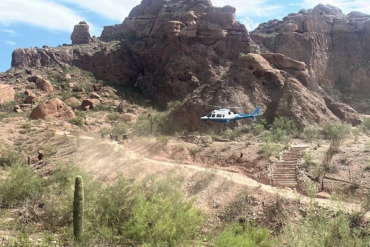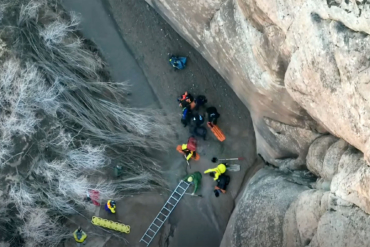Hiking is fun for the whole family, and the right baby carrier makes all the difference. A well-designed pack keeps your child safe and comfortable while giving you the support and storage to tackle everything from rugged trails to mellow loops.
Over the past five years, we’ve tested carriers everywhere from snowy Sierra talus to sandy Atlantic beaches, hauling newborns to 3-year-olds with testers from 5’1″ to 6’2″. After miles of hiking and plenty of kid-approved testing, we’ve narrowed down the best baby carriers for hiking.
From simple wraps to full-frame packs, this list has something for every adventure. Whether you want the feature-rich Osprey Poco Premium or the budget-friendly Kelty Journey PerfectFIT, these carriers will help you create unforgettable memories on the trail.
Editor’s Note: We updated our Baby Carriers Guide on August 25, 2025, to include two newly field-tested options: the Osprey Poco Soft Carrier, a cushioned, supportive option for all-day comfort, and the Deuter Kid Comfort, a proven favorite with excellent adjustability and durability.
The Best Baby Carriers of 2025
Kelty Journey PerfectFIT
- Pack weight: 6 lbs., 6 oz.
- Max weight: 50 lbs.
- Adjustable torso length: Yes
Pros
- Comfortable suspension system
- Dual grab handles assist in putting on and taking off
Cons
- Limited storage
- Sunshade not included
- No hydration bottle storage
Thule Sapling
- Pack weight: 7 lbs.
- Max weight: 48.5 lbs.
- Adjustable torso length: Yes
Pros
- Ample padding
- Dual zippered openings on vestibule
- Removable and washable child seat and drool pad
- Hydration pack compatible
- Side panel buckles for easy loading and unloading
- Even weight distribution
Cons
- Hard to access vestibule zippers when wearing the pack
- No water bottle pocket
- Sunshade does not have an integrated pocket
- Vestibule not quite big enough to support an overnight trip
Osprey Poco Soft Sided Carrier
- Pack Weight: 1.68 lbs.
- Max Weight: 33 lbs.
- Adjustable Torso Length: N/A
Pros
- Excellent support for parents and babies
- Versatile with three carry options
- Integrated rain cover
- Cool and breathable
Cons
- Difficult to use solo
- Waist strap catches brackets
- Only comes in one size/may fit tightly depending on size of wearer
Kelty Journey PerfectFIT Elite
- Pack weight: 7 lbs. 4 oz.
- Max weight: 50 lbs.
- Adjustable torso length: Yes
Pros
- Comfortable suspension system
- Dual grab handles assist in putting on and taking off
- Sunshade protects your kiddo
- Hydration sleeve makes on-the-go drinking easy
- Plenty of storage
Cons
- No way to tuck away buckle straps when loading
- Adjusting seat angle is not the smoothest
Other Baby Carriers Built for Family Adventures
- Pack Weight: 7.12 lbs.
- Max Weight: 40 lbs.
- Adjustable Torso Length: Yes
Pros
- Side load makes child loading a breeze
- Highly adjustable for child
- Breathable
- Supportive
Cons
- Sun shade needs work
- Not as much storage as the Osprey Poco Premium
- Pack weight: 5 lbs., 1 oz.
- Max weight: 48 lbs.
- Adjustable torso length: Yes
Pros
- Integrated sunshade
- Multiple storage options
- Well made design and storage compartments
Cons
- Very stiff until broken in
- Expensive
- Drool pad is not removable
- Pack weight: 5 lbs., 6.4 oz.
- Max weight: 33 lbs.
- Adjustable torso length: No
Pros
- Very budget friendly
- Lightweight
- Enough storage to pack items needed for the day
- Sunshade included
Cons
- Cheaply made and not durable for regular use
- Not comfortable for long days on the trail
- Pack weight: 2 lbs., 3.3 oz.
- Max weight: 33 lbs.
- Adjustable torso length: N/A
Pros
- Lightweight, packable
- Breathable and cool
- Supports infant through toddlerhood
Cons
- Steep learning curve to learn how to use and adjust
- No storage for small items like keys, phone and spare diaper
- No sun shade cloth
- Pack weight: 1 lb., 8.6 oz.
- Max weight: 45 lbs.
- Adjustable torso length: N/A
Pros
- Mesh is breathable and durable
- Cool and quick-drying
- Packable sunshade fabric
- Grows with baby
- Front and back wearing compatibility
Cons
- No storage for small items like keys, phone and snack
- Less support for carrying larger toddlers during extended hikes
Baby Carrier Comparison Chart
| Carrier | Price | Pack Weight | Max Weight | Cargo Capacity | Adjustable Torso |
|---|---|---|---|---|---|
| Osprey Poco Premium | $395 | 8 lbs, 6 oz. | 48.5 lbs. | 36 L | Yes |
Kelty Journey PerfectFIT | $270 | 6 lbs., 6 oz. | 50 lbs. | 17 L | Yes |
| Thule Sapling | $380 | 7 lbs. | 48.5 lbs. | 22 L | Yes |
| Osprey Poco Soft Child Carrier | $150 | 1.68 lbs. | 33 lbs. | Unavailable | N/A |
| Kelty Journey PerfectFIT Elite | $350 | 7 lbs. 4 oz. | 50 lbs.. | 26 L | Yes |
| Deuter Kid Comfort | $320 | 7.12 lbs. | 40 lbs. | 14 LL | Yes |
Osprey Poco LT | $300 | 5 lbs., 1 oz. | 48 lbs. | 21 L | Yes |
Clevrplus Cross Country Baby Backpack | $110 | 5 lbs., 6.4 oz. | 33 lbs. | Unavailable | Yes |
Baby Bjorn Air One | $219 | 2 lbs., 3.3 oz. | 33 lbs. | N/A | No |
| Ergobaby 360 | $140 | 1 lb., 8.6 oz. | 50 lbs. | N/A | N/A |

How We Tested the Best Baby Carriers
Our Testing Grounds & Process
For over 5 years, we have been testing wraps, soft carriers, and backpacks in search of the best ways to explore the outdoors with the kids in our lives. From 2018 to 2023, we used these packs on hikes in the Pacific Northwest and through many of the mountains in Georgia and Southern Colorado. After a winter of record snowpack in the Sierra Nevada of California, we knew we needed to get more miles on our old faithful and test out some new contenders in the baby-carrying arena.
We hauled our kids over snow fields and across creeks out of Mammoth, Calif., through flooded trails and boulder fields, dodging thick poison oak in Yosemite Valley, and up to dreamy alpine meadows out of the 20 Lakes Basin in the Inyo National Forest.
We traveled through busy cities and airports and put miles on our cars to get to outdoor meccas as close as Lake Tahoe and as far as Flagstaff, Ariz. We’ve gone up to 13,000 feet on Mt. Dana and all the way down to sea level, testing a total of 15 carriers.
Our Expert Testers
Our first testers were PJ Solomon and Cameron King, who are Wilderness and Climbing Rangers for the National Park Service, respectively. These two have decades-long experience carrying heavy loads out to remote destinations, often deep in the backcountry of the Southwest, the Sierra Nevada, and the mountains in Colombia, crags in Italy, Spain, and Greece, and cities throughout the U.S.
Since day one, they have made it their priority to continue enjoying the outdoors with their daughter. First, they used fabric wraps and soft carriers, eventually graduating to a backpack when their child could sit up independently.
But don’t just take their word for it. They also enlisted neighbors and friends from the foothills of Yosemite National Park; parents of children ranging from 3 months old to 3 years old. Most of these other parent testers work in Yosemite National Park as guides, educators, and rangers. In 2025, GearJunkie editor Morgan Nowels joined the ranks of parenthood and took over testing for this guide.
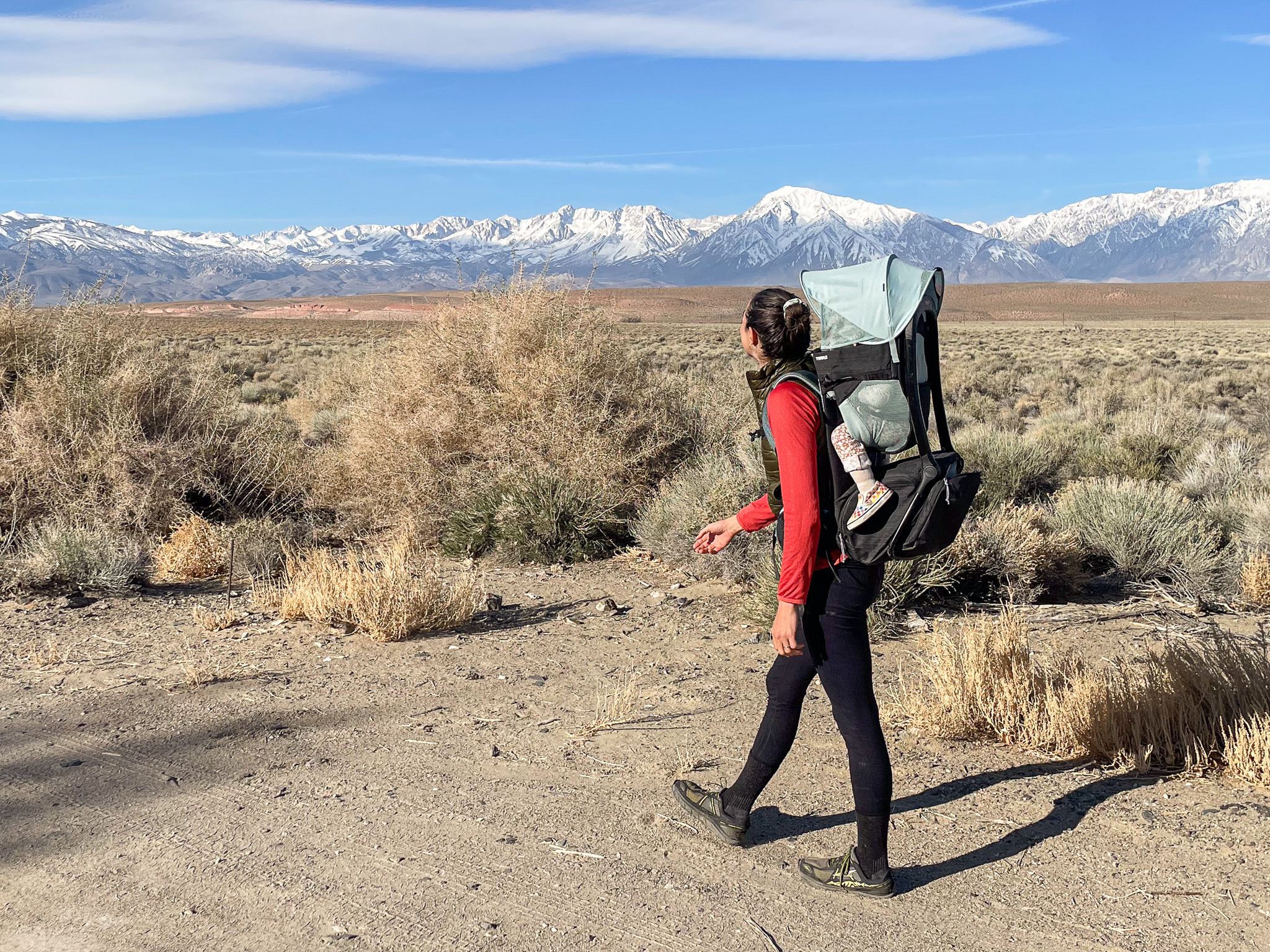
We wanted non-parent testers to try out these packs as well, so we asked a few neighbors who had young nieces and nephews to give the carriers a whirl. It is important to be able to see these packs through the eyes of someone who has never carried a kid in a carrier or pack before to shine light on our biases and give us real perspective into the usability and ease of learning these sometimes complex harness systems.
Each pack was tested by at least two separate families and was given a minimum of 5 miles with each test. Our team evaluated products based on their construction quality, ease of use, comfort for both caregiver and kid, and most importantly, safety.
We consulted local pediatricians in Mariposa and Fresno and checked in with the International Hip Dysplasia Institute to ensure these carriers could be adjusted to optimize the hip and leg health of our kids. We took time to carefully pick apart each product to ensure we could share accurately how they each work so you can make the best decision for your little or big family. If you want to get fully kitted out for hiking adventures, check out our guide to the best hiking boots, best hiking boots for women, and the best hiking shoes for women.
Buyer’s Guide: How to Choose a Baby Carrier for Hiking
Choosing the best carrier depends on various factors and is as personal as each hiking family’s uniqueness. In this instance, trying on a few can really help shape your decision.
If you have friends with their own carriers, ask to test it out or head over to your local REI or secondhand gear shop to try on a few before buying.
Types of Child Carriers
Wraps
These are basically long pieces of fabric. Many first-time parents are intimidated by having to tie the wrap on, but it becomes a simple process with practice. Wraps can be worn on hikes but tend to need to be tightened if worn for many hours or during semi-strenuous exercise.
They also don’t allow for much breathability for carrier and infant and are usually best utilized during walks around the neighborhood or while traveling, but a wrap isn’t the best choice for older children or longer hikes.
Slings
Also called ring slings, these carriers comprise a long piece of fabric with two rings at one end. It’s worn across the body and is suitable for infants and older children alike.
These are great for traveling and running errands, as you can quickly move the baby in and out. But it’s not the best choice for hiking. The entire weight is on one shoulder, and there’s no way to carry any extra gear.

Frameless, Soft-Structured Carriers
These are very common and include the Osprey Poco Soft Sided Carrier, Baby Bjorn Air One and Ergobaby carriers. They have padded straps and easily adjust similarly to a backpack. Depending on the particular carrier, Baby can be worn on the front facing in or out and on the back facing in.
These carriers are also a great option for older toddlers who want to walk much of the hike but may need to be carried at some point. They can easily ride on the back, and the carrier is light enough to take along just in case.
While these types of carriers are more structured and sturdy than a simple fabric wrap, they are still versatile and packable. They can be a necessary item for hiking, airplane travel, and backpacking trips, especially if you or your little one prefers a contact nap.
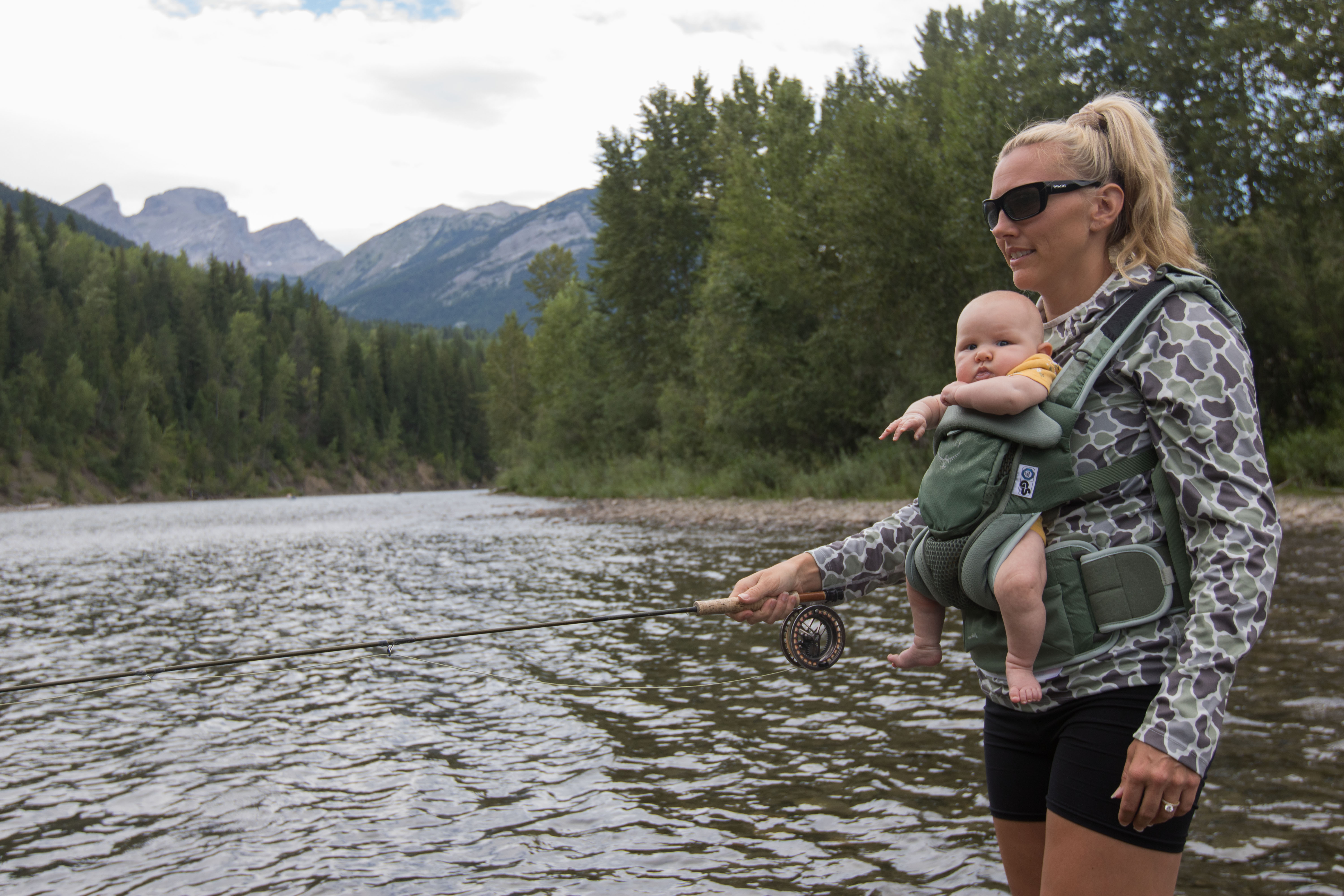
Backpack Child Carriers
Backpack carriers like the Osprey Poco Premium or Thule Sapling have many of the same design features as backpacking packs. They’re built for long days outside and make hauling more weight and gear possible.
With an adjustable torso length, padded waist belt, and plenty of storage, these are your best option for hiking and backpacking with most kids.

Comfort for Long Distance vs. Lightweight Packs
It’s important to consider the comfort of the adult carrying and the kiddo riding along, especially for longer day hikes and multiday trips. Packs like the Thule Sapling designed for long-distance comfort will usually include a steel frame and lots of pockets for storage. These packs also have more features, allowing for wider adjustment ranges on the torso and hip to accommodate heavier loads on various body sizes.
The cockpit for the child will also be designed with longer sitting times in mind and comfort for afternoon naps. Comfort is key in these designs, so you will see thicker padding in shoulder straps and hip belts. Because of these extra features and more durable materials used, packs designed for long-distance hiking will be heavier, even without a kid or gear inside.
Lightweight packs are built for packability and low-mileage travel. They do not offer feature-rich designs and often have less padding in shoulders and hip belts. But what they lack in bells and whistles, they deliver in ease of use and versatility.
The Ergobaby 360 and other soft carriers can be stuffed in a carry-on and allow you to strap in children from infancy through toddlerhood. Framed lightweight packs can offer enough storage and comfort to carry your child for a few hours on the trail and pack well in your car for a road trip through your favorite outdoor destinations.
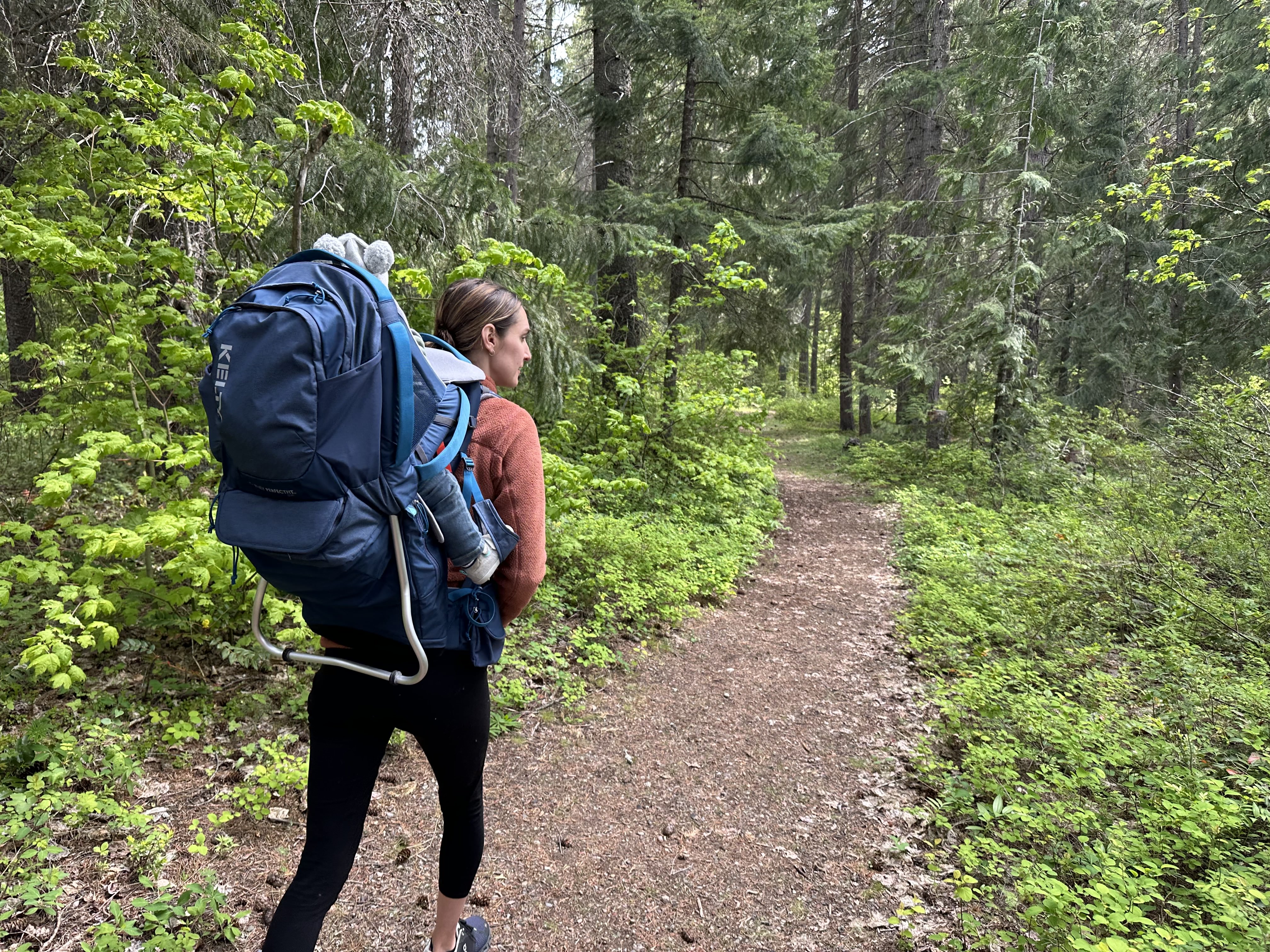
Adjustability and Ease of Use
Do you want a pack that just fits you or one that can switch between parents, grandparents, and hiking friends? If you and your partner want to use the pack interchangeably, it’s worth it for each of you to try on a few before committing. If multiple people will be on carrying duty, look for a pack that offers adjustability in the torso length and hip belt to fit everyone.
Most packs also offer a wide range of size adjustability for the cockpit or seat for the child. Read the manual and make initial adjustments to the pack before putting your kiddo inside.
We’ve had great success with the Osprey Poco Premium and the Kelty Perfectfit Elite fitting parents, grandparents, and friends interchangeably.
If you plan to do most trips solo, make sure you are getting a carrier or pack that is easy to use and adjust on your own. We like the stability and low center of gravity of the Osprey for framed packs and the clipless strap systems of the frameless BabyBjorn.
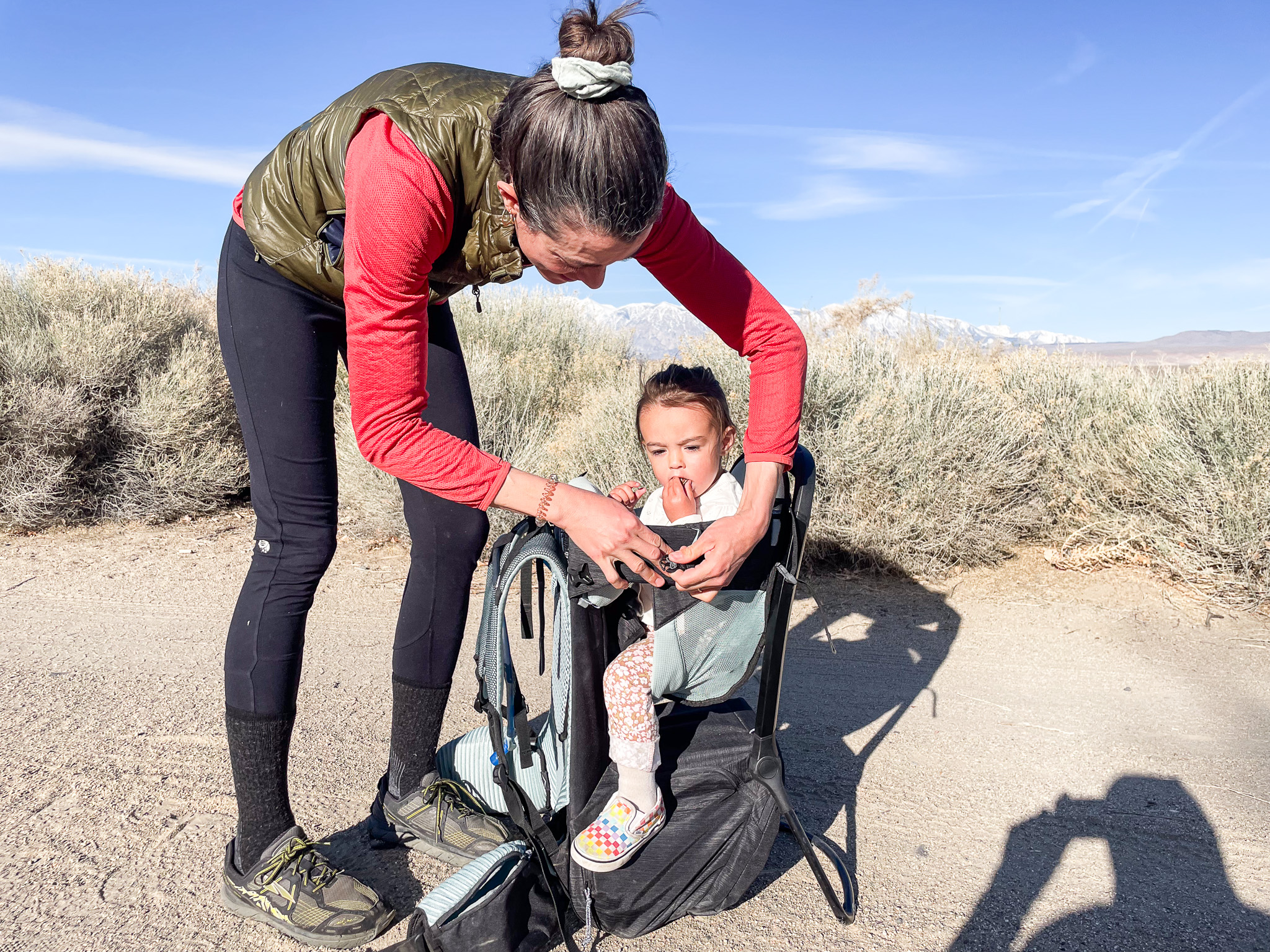
Suspension, Padding, and Breathability
Carrying a 40-pound pack is no joke — especially when that weight comes in the form of a wiggling, giggling (or screaming) toddler. A well-fitting pack is what you need to find first, then look to other comfort or convenience features before you buy. Anytime you are shopping for a pack, look to the hip belt first.
The padding on the hip belt should feel good on your hips and should not rub or put pressure in any one place. The torso and shoulder straps should adjust enough to bring weight ranging from 10 pounds to 40 pounds comfortably on your hips and the pack panel should rest lightly across the length of your back.
If you live in a warm climate or plan to use your carrier or pack during the summer months, consider the breathability of the fabric. Look for mesh and/or suspended panels or packs made from lightweight, breathable materials to prevent excessive sweating and discomfort for both you and your passenger. If breathability is high on your list, something like the Ergobaby 360 Cool Air or the Deuter Kid Comfort would be a good choice.

Child Comfort, Stirrups, and Safety
Babies and toddlers will let you know when they are not comfortable. If possible, try on a few packs with your little one so you can gauge how their bodies feel about the harness, seat, and drool pads.
Find a harness that clips comfortably and doesn’t rub or pinch. The Poco LT has easy-to-use harness systems that get kids locked in quickly and without fuss. The Kelty Journey has a more complex harness but is still incredibly supportive and structured.
The cockpit, the space surrounding where the child sits, should have high walls and a well-cushioned pad in the front, allowing them to be secure in their seat, and have a soft landing for their heads if they fall asleep. A low-sitting, cushioned seat will keep your kiddo comfortable while keeping a low center of gravity, helping you stay steady when taking off and putting on your loaded pack.

Safety should be your top priority when baby wearing and carrying. Buckles should lock securely and stitching should be durable. Straps should be adjustable for both your comfort and for the comfort and safety of your child. In framed packs, stirrups are employed to help bigger babies and tots adjust themselves to stay comfortable. They also help keep hips in a stable and healthy position and they help keep the legs from falling asleep or getting uncomfortable.
Children under the age of 1 should sit with legs in the “M” position, with knees slightly higher than hip level, to help prevent hip dysplasia. Take a picture or bring in your carrier to your next pediatrician visit to ensure you are carrying your infant in a hip-healthy way.
Size and Storage
If you plan to take half-day hikes or neighborhood jaunts, then something lightweight and on the lower end of the price and feature spectrum could serve you well, like the Clevr Plus. But if you plan to regularly hit the trail on long day hikes or multiday backpacking trips, you’ll need a pack with extra accessories like a sunshade, rain cover, and extra pockets.
Also, look for large storage compartments at the bottom of the pack to allow you to carry heavy gear while still keeping your center of gravity low.
The other useful features to consider include a hydration system, easy-to-access water bottle holders, toy clips, and toddler-accessible snack pockets. For these extra features, we love the Osprey Poco Premium.
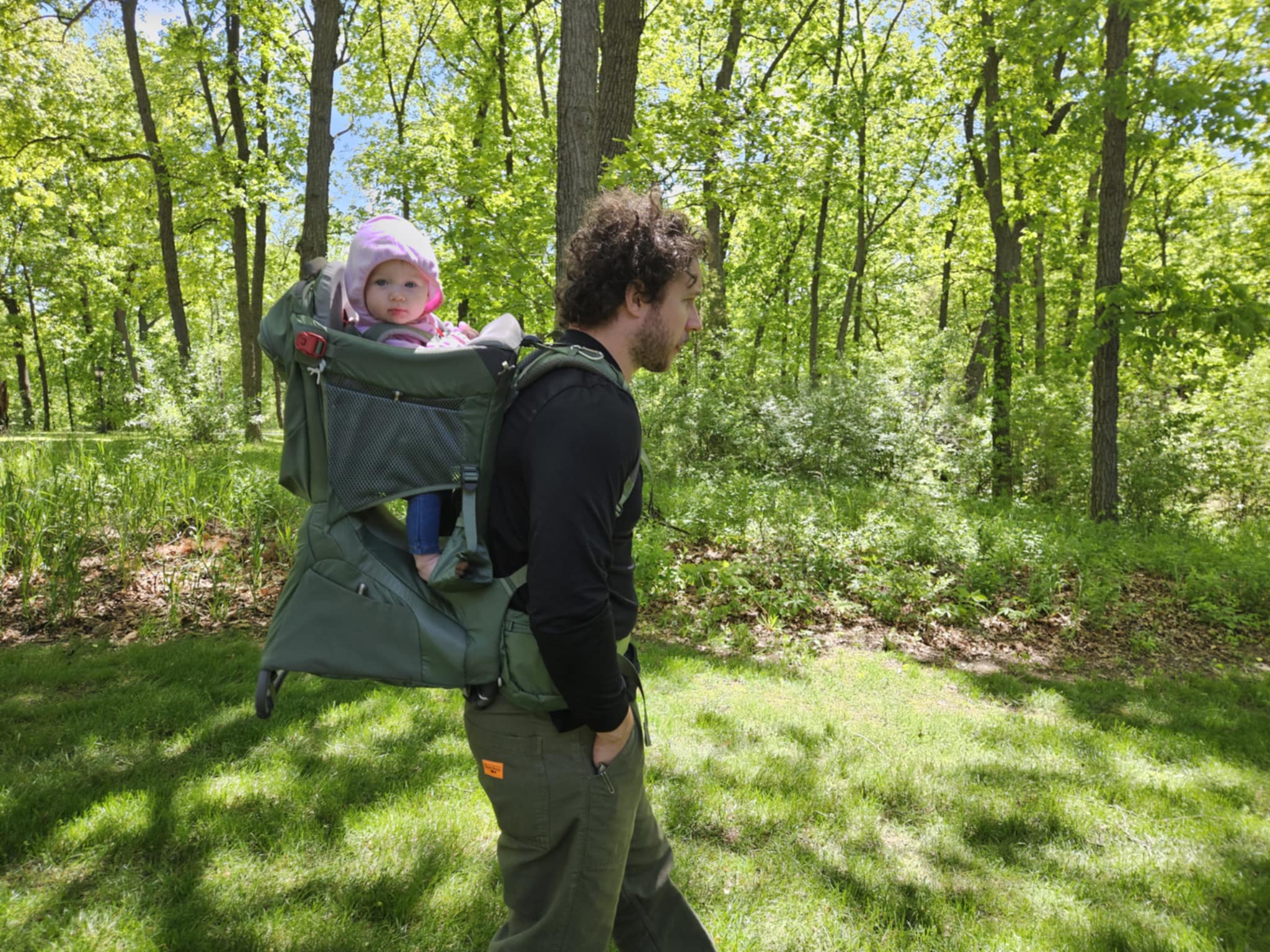
Sunshade and Rain Covers
Keeping our tots protected from the sun is paramount on the trail. You can forgo a sunshade and instead rely on a hat and sunscreen. But after years of being in the mountains with our kids, we thoroughly recommend a sun cover.
Not only will it protect your child’s skin from sunburns, but it will also keep the temperature much lower in the cockpit on hot days. Shade flaps on the side are especially helpful when kids decide to take a snooze mid-trail.
Premium packs like the Osprey Poco Premium include an integrated sunshade with side protection. It packs into the carrier easily, so you never have to worry about forgetting it. The Kelty Perfectfit Elite also comes with a detachable and stashable sun shade.

We’ve also found the sunshade is useful for protecting against light rain. But you’ll need a true rain cover to stay dry in heavy or sustained rainfall. Rain covers are sold separately for Osprey and Deuter but can come in handy if you hike in areas where afternoon storms and precipitation are common. Keep in mind that rain protection of any kind is not well ventilated so may not be helpful in hot and humid climates.
Tips for Hiking With Babies & Kids
Safety First
For young babies, remember they need to have full head control before it’s safe to ride in a backpack carrier. If they can’t yet sit up, consider using a soft carrier with head and neck support like the Tula or Ergobaby. Work with your pediatrician to prevent hip dysplasia and ensure you are carrying your under-1-year-old in the proper position to support their hip development and leg comfort.
Don’t Give Up
What kids complain or cry about one day could be their favorite thing next week. If you are a parent or caregiver, you know nothing is linear. The first time one of our testers placed her daughter in a backpack carrier, she shrieked unhappily. But she was completely content the following week. By 8 months old, she gets excited any time she sees it and will joyfully spend hours outdoors.
Some of our 2-year-old testers were begging to go hiking when they saw new packs they could ride. Hang in there, and if it’s important to you, keep trying.

Remember the Main Objective
Don’t forget: The entire point is to enjoy being outside together. Set aside the need to make it to the top and enjoy whatever comes of the day.
Maybe you end up sitting under a tree for a nap, maybe you dangle a few toys on the pack for entertainment, or maybe you take it a bit slower. And, most importantly, always pack extra snacks.
At the end of the day, the main goal is to foster a love of the outdoors in our kids. Make these outings fun from the get-go and you’ll soon have a pint-size trail buddy. So grab your friends, buckle the baby into the pack, and get outside.
Price & Value
Baby carriers for hiking range in price from about $100 to upward of $400. Budget is an important consideration, but you’ll also want to choose a baby carrier based on how often you’ll use it and what your primary use will be.
Budget
You can find a solid budget-friendly option within the $100-150 range. Our top soft-sided carrier, the Osprey Poco Soft Sided Carrier ($150) is frameless, supportive, breathable, and packable. It lacks storage for items like phones, keys, and snacks, and it’s not as supportive as other pricier options. Similarly, the ClevrPlus Cross Country baby backpack falls short in comfortably supporting heavier loads and longer treks, but it’s ideal for shorter, infrequent hikes. If you plan on taking long adventures and want more comfort, support, and bells and whistles, you’ll have to pay more.
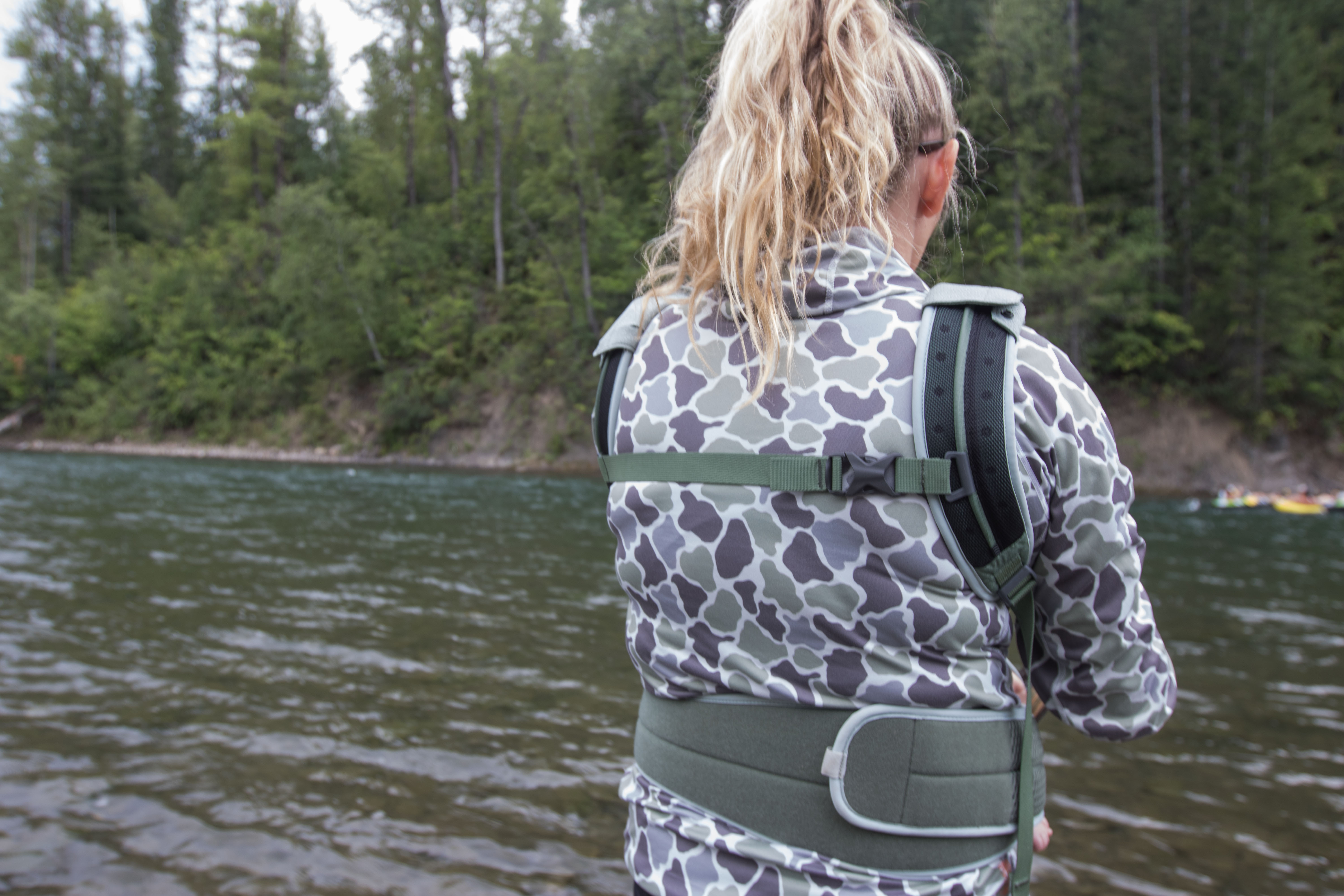
Mid-Tier
For $200-300, your baby carrier will come with a bit of added support and a few more features. Our best budget-friendly pick, not the lowest-priced of all on our list, but a solid value, the Kelty Journey PerfectFIT ($270) has pared-down perks, especially compared to some of its competitors.
But, it was one of the most comfortable we tested and it’s still made with a high-quality aluminum frame and durable straps and fabrics which will allow you countless day adventures. It has a lot less storage than our premium picks, so it’s ideal for day adventures or longer ones where your partners can carry other gear.
Premium
Jumping up to this level brings many more features and comfort, but these carriers can cost over $300. Our top overall pick, the Osprey Poco Premium, has it all: Comfort, versatility, durability, support, and a number of additions like a sunshade and hydration sleeve compatibility. It will accommodate your child through several growth stages, so it will last a long time. The Thule Sapling ($380) is a rugged, lightweight pack ideal for overnights, so it has ample storage, comfort, and durability.
Frequently Asked Questions
The best child carrier backpack depends on a few things. You’ll need to answer a few questions:
First, how far are you hiking and how often? If you’re going longer distances or plan to regularly use your baby carrier, it’s worth investing more in a higher-quality pack. Second, what’s your size, and how big is your kiddo?
We found the Kelty Journey PerfectFit and Perfectfit Elite, the Osprey Poco LT, and Poco Premium fit a wide range of parents and delivered excellent comfort for kids. These packs also had high-functioning storage systems that can support carrying a child and some camping gear.
The big thing to look for is full head control. Babies weighing in at 16-plus pounds (about 6 months old) who can sit independently are good candidates. Keeping knees slightly higher than hips in an “M” position, especially before the age of 1 is also important according to the International Hip Dysplasia Institute. We recommend consulting your pediatrician to find out what is best for your baby.
And if you want to hit the trail earlier, consider a soft carrier like the Ergobaby 360 with infant insert or BabyBjörn.
You don’t need any piece of gear to enjoy being outdoors. But having the right gear can make it a better experience.
If you plan to only occasionally hit the trail with your kid, then a dedicated hiking backpack may not be necessary. In that case, a versatile soft pack like the Ergobaby 360 Cool Air Mesh with the infant insert can easily transition from newborn to toddler. It can be worn front or back and is great for travel, too.
But if you want to hike (or even backpack) with your baby, a hiking baby carrier is recommended. It offers superior support for heavy loads and has adequate gear storage for a day on the trail
It’s all about layers. For cool mornings, we like starting with a lightweight wool top and then layering a fleece on top. And of course, you don’t want to forget a hat (or two). For more help, check out some of our favorite kids’ clothes. From sunhats to jackets, you’ll find everything you need to get outside.
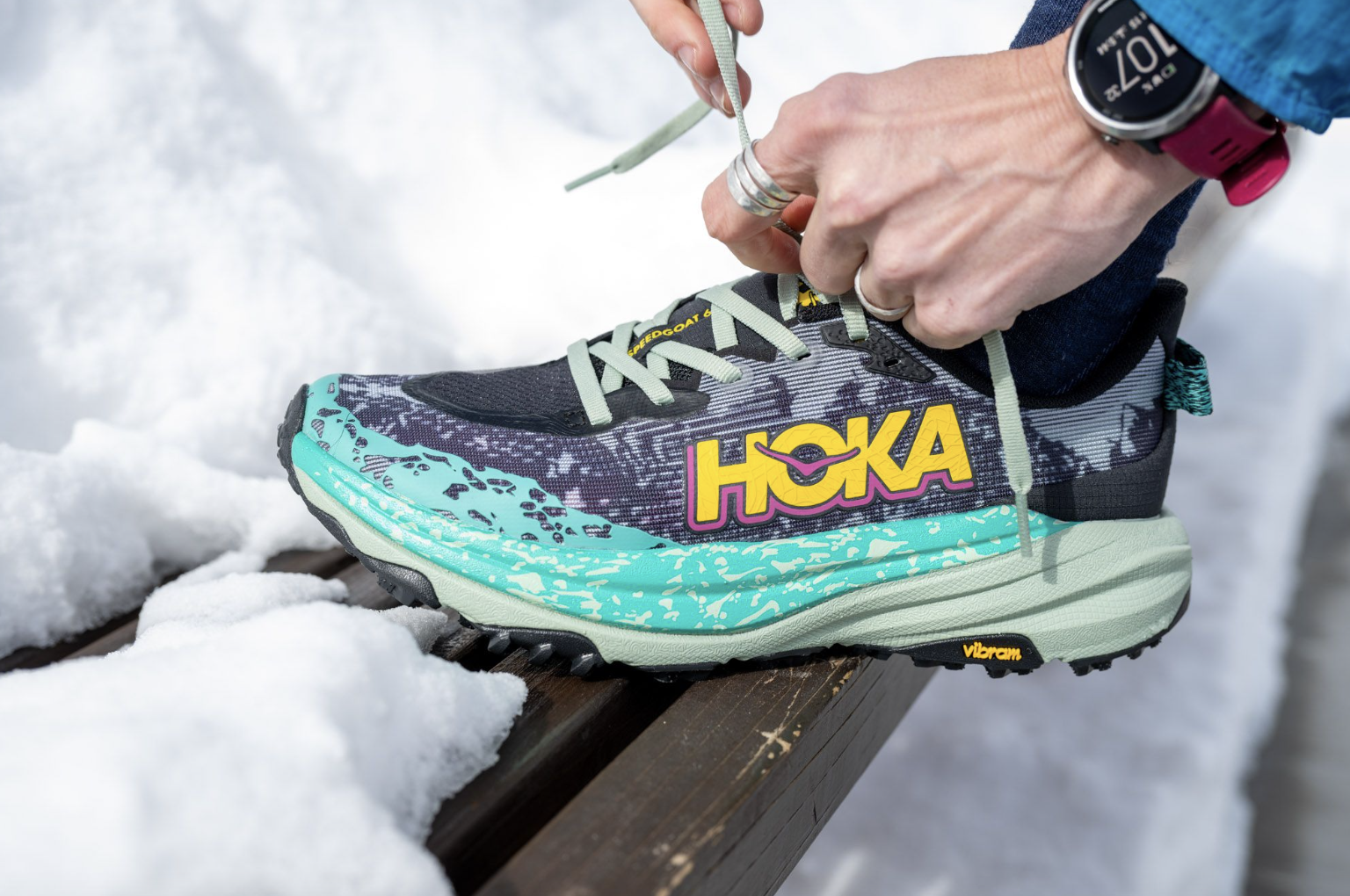
The Best Hiking Shoes of 2025
We tested and ranked the best hiking shoes for men and women for 2025, including top picks from Hoka, Salomon, Merrell, SCARPA, and more.
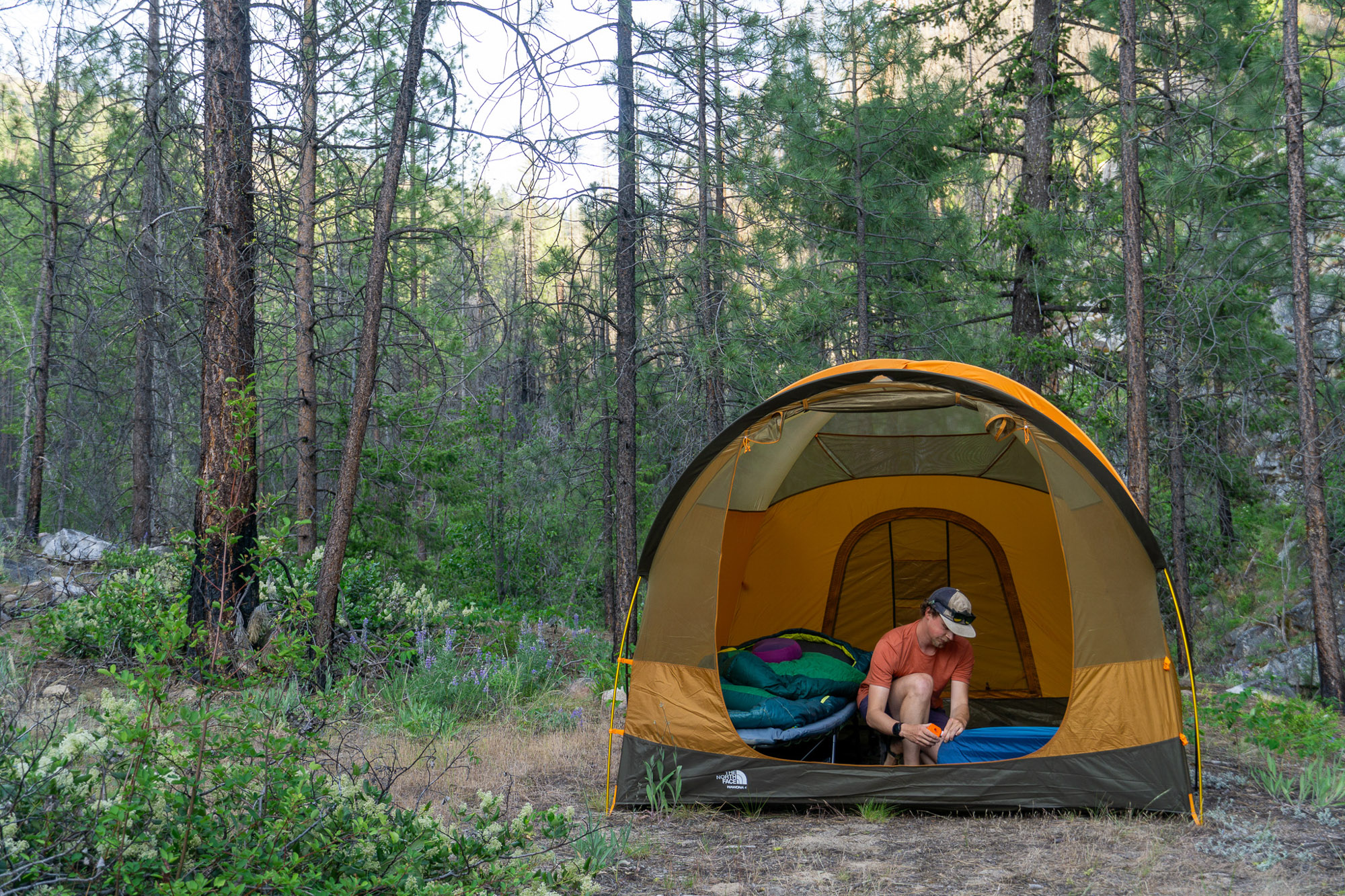
The Best Camping Tents of 2026
We make finding the right camping tent easier for you by bringing you the best camping tents of 2025. Check out our top picks from REI Co-op, Kelty, NEMO, and more.

